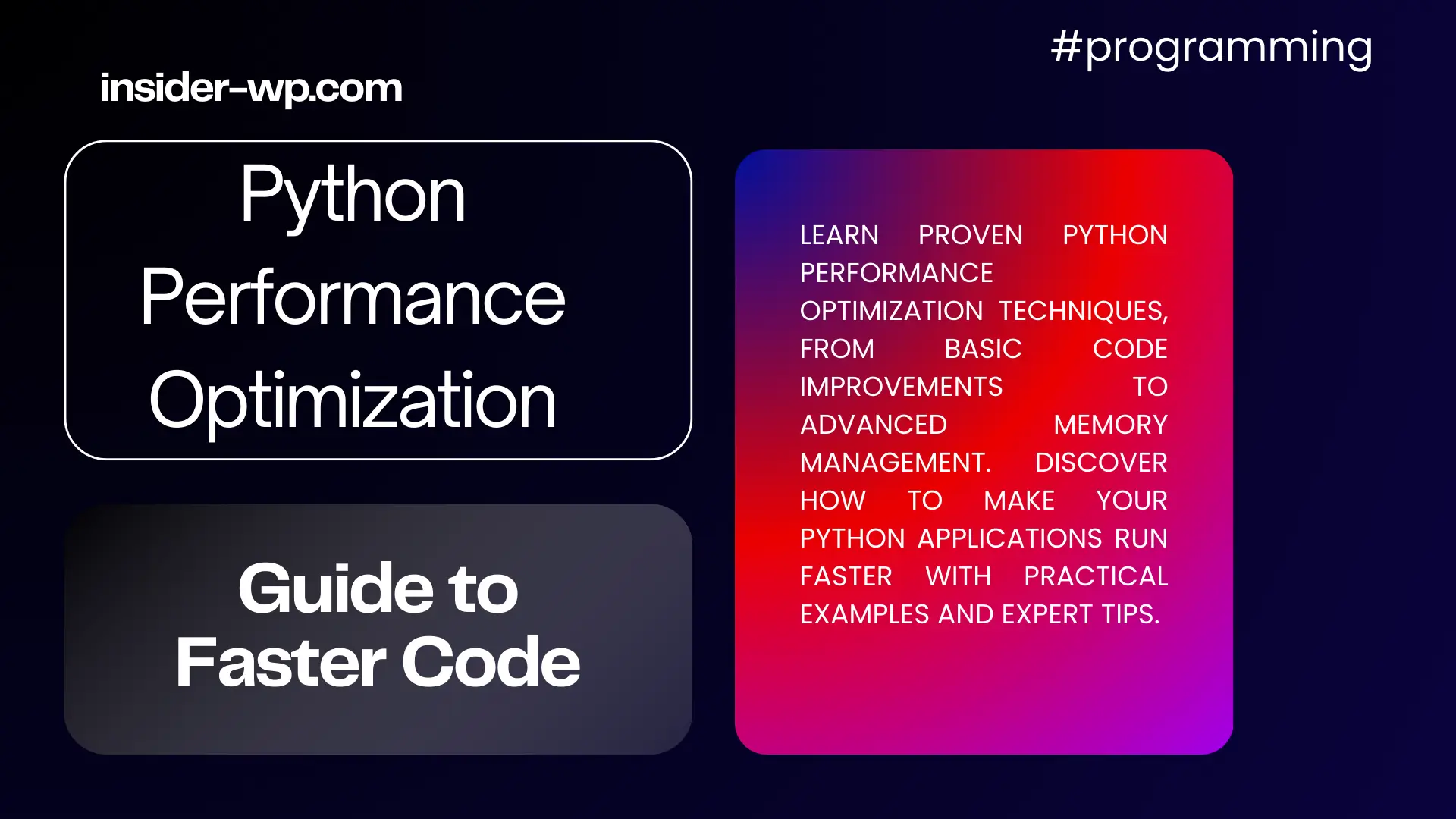Workplace Adaptability: Succeed in a Dynamic Career
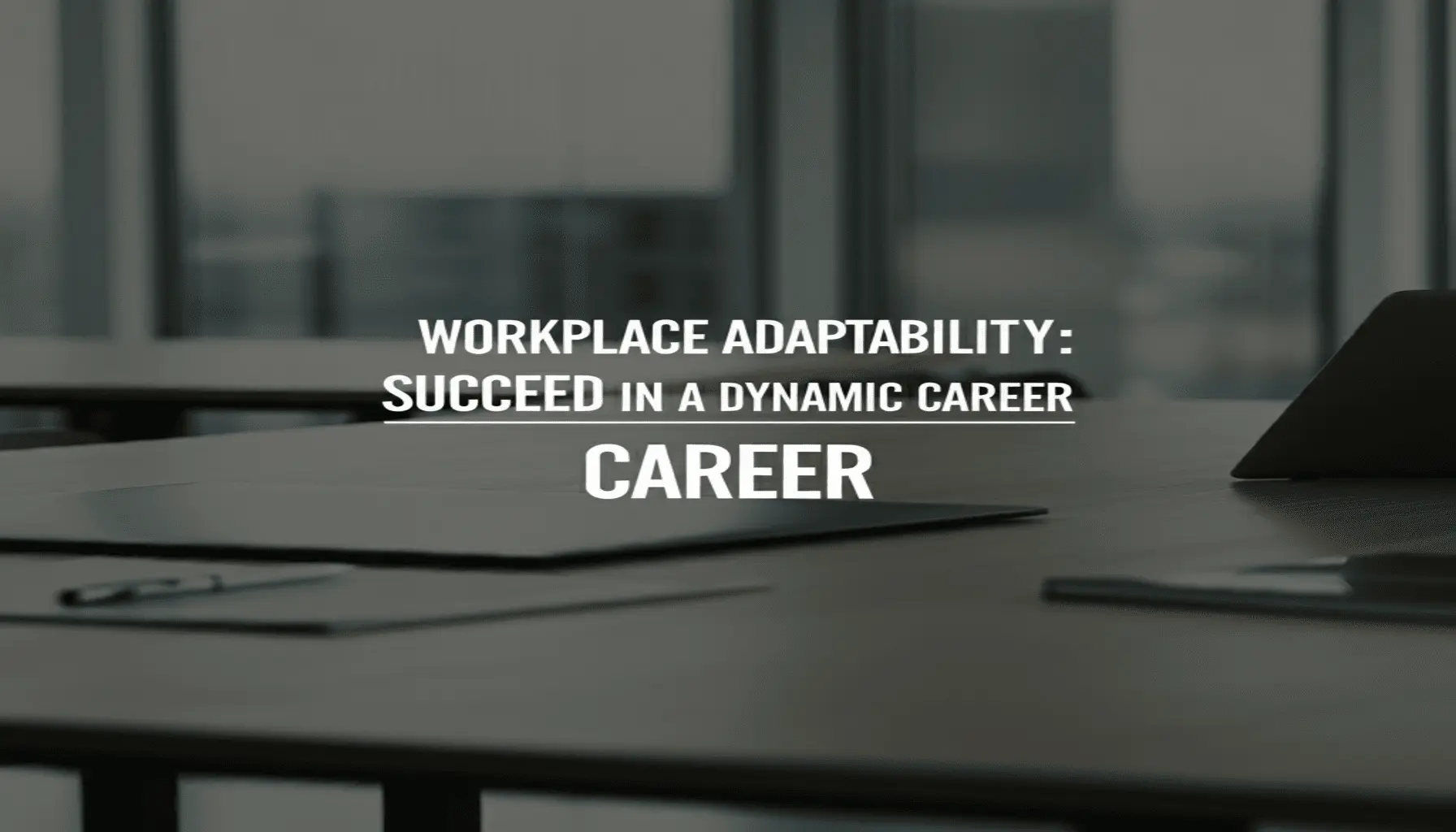
In today’s rapidly evolving professional landscape, adaptability in the workplace has become more than just a buzzword—it’s a critical skill for career success and organizational growth. As industries undergo constant transformation and disruption, the ability to embrace change and navigate uncertainty has emerged as a defining characteristic of high-performing individuals and resilient companies.
According to a recent study by McKinsey & Company, 94% of executives believe that adaptability and agility are critical to their organization’s success. This statistic underscores the growing importance of workplace adaptability in today’s business world.
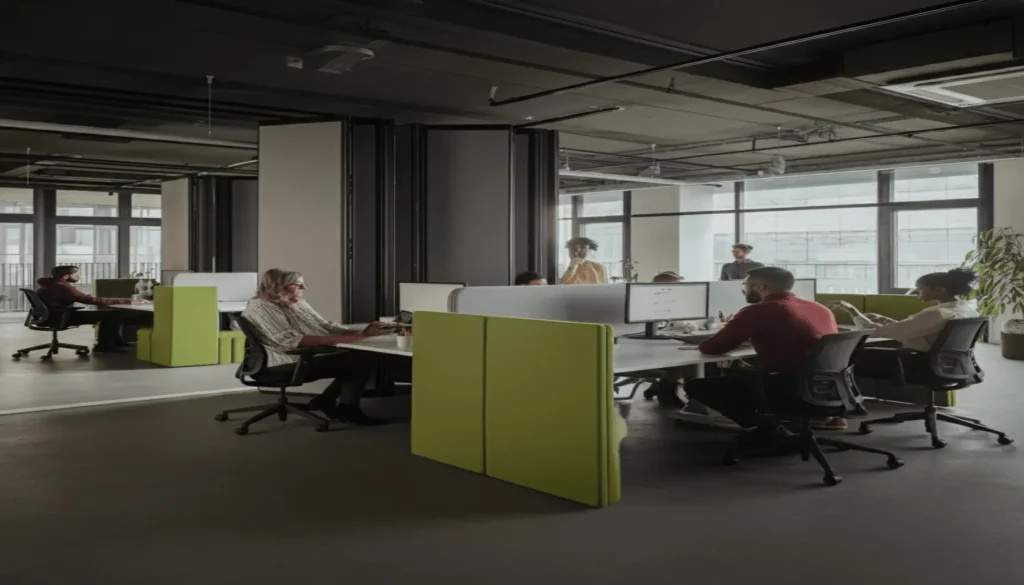
In this comprehensive guide, we’ll explore the multifaceted nature of adaptability, its benefits for both employees and employers, and practical strategies for developing this essential skill. Whether you’re a seasoned professional looking to future-proof your career or a business leader aiming to foster a more adaptable workforce, this article will provide you with valuable insights and actionable tips to thrive in the face of change.
Key topics we’ll cover include:
- Understanding the concept of adaptability in the workplace
- The importance of adaptability for individual and organizational success
- Key pillars of workplace adaptability
- Practical strategies for developing adaptability skills
- Overcoming common challenges to adaptability
- The role of leadership in fostering an adaptable work environment
- Future trends and the evolving landscape of workplace adaptability
By the end of this article, you’ll have a robust toolkit for enhancing your adaptability, boosting your resilience, and seizing opportunities in an ever-changing work environment. Let’s dive in and explore how you can master the art of adaptability to stay ahead in your career and drive success in your organization.
Understanding Adaptability in the Workplace: What Does It Really Mean?

In today’s fast-paced, ever-changing work environment, adaptability isn’t just a nice-to-have skill—it’s essential for survival and success. But what exactly do we mean when we talk about adaptability in the workplace?
Defining Workplace Adaptability
Workplace adaptability is the ability to adjust and thrive in response to changing circumstances, challenges, and opportunities in your professional environment. It’s about being flexible in your approach, resilient in the face of setbacks, open to new ideas, and committed to continuous learning.
Think of adaptability as your professional superpower—it allows you to:
- Navigate uncertainty with confidence
- Embrace change as an opportunity for growth
- Pivot quickly when faced with unexpected challenges
- Stay relevant in an ever-evolving job market
The Four Key Components of Adaptability
Adaptability in the workplace isn’t a single skill, but rather a combination of several interconnected qualities. Let’s break down the four key components:
- Flexibility: The ability to adjust your approach based on new information or changing circumstances.
- Resilience: The capacity to bounce back from setbacks and maintain a positive attitude in the face of challenges.
- Openness to change: A willingness to embrace new ideas, technologies, and ways of working.
- Continuous learning: An ongoing commitment to acquiring new knowledge and skills to stay relevant and effective.
Let’s visualize how these components work together:
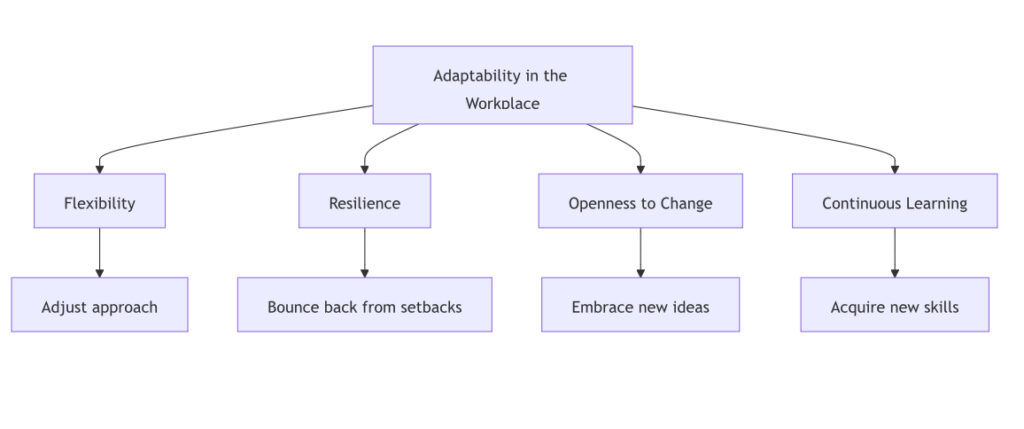
Adaptability vs. Flexibility vs. Resilience: Understanding the Differences
While adaptability, flexibility, and resilience are closely related, they’re not interchangeable. Here’s a quick comparison to help you understand the nuances:
| Concept | Definition | Focus | Example |
| Adaptability | The overall ability to adjust and thrive in changing environments | Comprehensive response to change | Pivoting your business model in response to market shifts |
| Flexibility | The ability to bend without breaking, to be willing to change or compromise | Short-term adjustments | Shifting your work hours to accommodate a client in a different time zone |
| Resilience | The capacity to recover quickly from difficulties | Bouncing back from adversity | Maintaining motivation after a project setback |
Adaptability encompasses both flexibility and resilience, along with openness to change and continuous learning. It’s the overarching quality that allows you to navigate the complex, ever-changing landscape of modern work.
Real-World Examples of Adaptable Employees
Let’s bring these concepts to life with some real-world examples of adaptability in action:
The Tech-Savvy Teacher
When schools shifted to remote learning during the pandemic, many teachers had to quickly adapt to new technologies and teaching methods. Those who embraced the change and continuously learned new digital tools not only survived but thrived in the new environment.
The Agile Project Manager
In a fast-paced tech startup, a project manager regularly adjusts project timelines and resources based on changing client needs and market conditions. Their flexibility and openness to change ensure projects stay on track despite constant shifts.
The Career Pivoter
A marketing professional notices the growing demand for data analysis skills in their field. Instead of resisting the change, they proactively take online courses in data analytics, successfully transitioning into a marketing analytics role and staying relevant in their industry.
The Resilient Salesperson
After losing a major client, a salesperson doesn’t let the setback derail their performance. Instead, they analyze what went wrong, learn from the experience, and use those insights to improve their approach with future clients.
These examples showcase how adaptability—with its components of flexibility, resilience, openness to change, and continuous learning—enables professionals to navigate challenges and seize opportunities in diverse work situations.
By cultivating adaptability, you’re not just preparing for change; you’re positioning yourself to thrive in it. In the following sections, we’ll explore why adaptability is so crucial in today’s workplace and how you can develop this essential skill set
What are the 5 ways of adaptability?
While adaptability can manifest in many ways, here are five key aspects:
- Cognitive Adaptability: The ability to adjust your thinking and problem-solving approaches
- Emotional Adaptability: Managing your emotions effectively in the face of change
- Social Adaptability: Adjusting your interpersonal style to work well with different people
- Physical Adaptability: Being flexible with your work environment or physical demands of your job
- Learning Adaptability: Continuously acquiring new skills and knowledge
Now, let’s visualize these five aspects of adaptability. Use the sliders below to rate your own adaptability in each area and see how they come together in the radar chart:
This visualization can help you identify your strengths and areas for improvement in adaptability. Remember, there’s always room for growth in all these areas!
The Importance of Adaptability in the Workplace
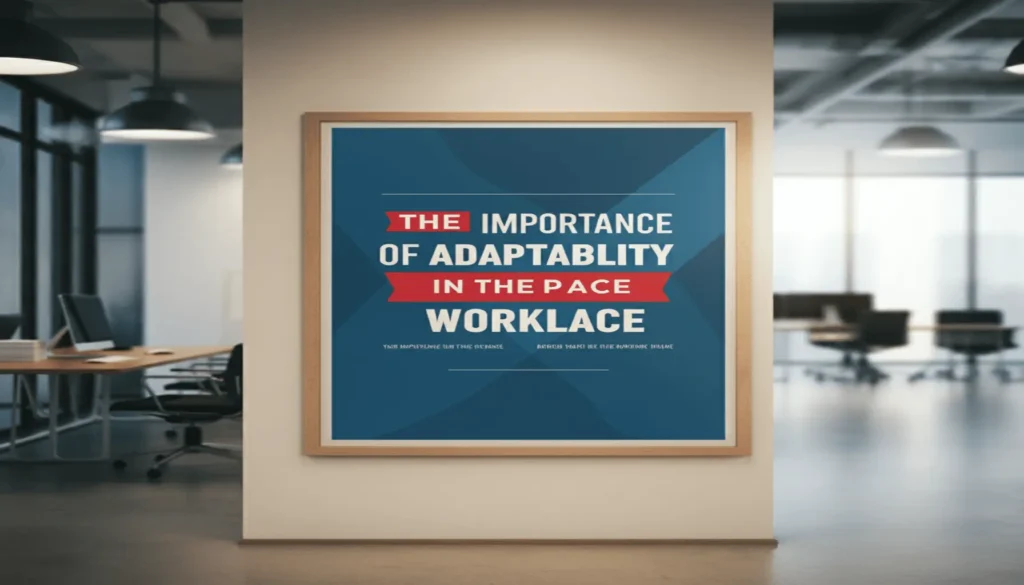
In today’s rapidly evolving work environment, adaptability isn’t just a nice-to-have skill—it’s a critical competency for both individual and organizational success. Let’s dive into why adaptability in the workplace matters so much and explore its far-reaching benefits.
Benefits for Individual Career Success
Adaptable employees are like the Swiss Army knives of the professional world—versatile, reliable, and always in demand. Here’s how adaptability can supercharge your career:
- Increased Job Security
- Adaptable employees are more likely to weather organizational changes and industry shifts.
- They’re often the last to be let go during downsizing, as they can easily transition into new roles.
- Example: During the COVID-19 pandemic, employees who quickly adapted to remote work were more likely to retain their positions.
- Enhanced Career Growth Opportunities
- Adaptable individuals are prime candidates for promotions and new roles.
- They’re more likely to be chosen for cross-functional projects and leadership positions.
- Their ability to learn new skills quickly makes them valuable in various contexts.
- Improved Problem-Solving Skills
- Adaptability fosters creative thinking and innovative problem-solving.
- Adaptable individuals approach challenges from multiple angles, increasing their chances of finding effective solutions.
- They’re more comfortable with ambiguity and can make decisions in uncertain situations.
To illustrate these benefits, let’s look at a comparison of career trajectories:
| Career Aspect | Highly Adaptable Employee | Less Adaptable Employee |
| Job Retention | More likely to be retained during organizational changes | May struggle to justify their role in changing environments |
| Promotion Rate | Faster promotions due to versatility | Slower career progression |
| Skill Development | Continuously acquires new skills | May resist learning new technologies or methods |
| Problem-Solving | Approaches problems creatively | May struggle with unfamiliar challenges |
| Leadership Potential | Often identified as future leaders | May be overlooked for leadership roles |
Benefits for Organizations
Organizations that foster adaptability among their workforce gain significant advantages in the marketplace:
- Innovation and Improved Performance
- Adaptable organizations are more likely to innovate and stay ahead of industry trends.
- They can quickly pivot strategies in response to market changes or new opportunities.
- Adaptable teams are more productive and efficient, as they’re always looking for better ways to work.
- Competitive Advantage
- Companies known for their adaptability attract top talent.
- They’re better equipped to meet changing customer needs and preferences.
- Adaptable organizations can often outmaneuver less flexible competitors.
- Navigating Uncertainty
- Adaptable organizations are more resilient in the face of economic downturns or industry disruptions.
- They can quickly reallocate resources and adjust strategies as needed.
- These companies are better prepared for unforeseen challenges and opportunities.
To visualize how adaptability impacts organizational success, consider this diagram:
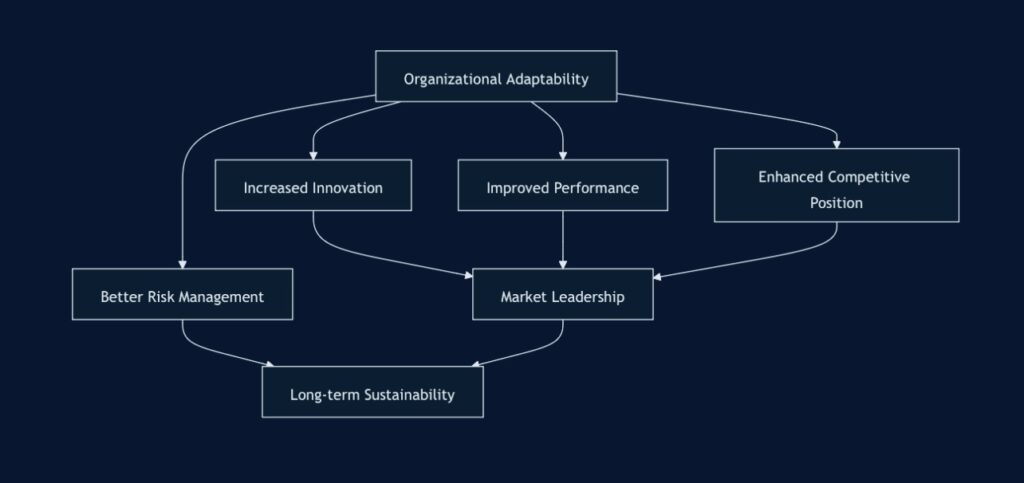
Real-World Success Stories of Adaptable Companies and Individuals
Let’s look at some inspiring examples of adaptability in action:
- Netflix: Once a DVD rental service, Netflix adapted to streaming technology and then became a content producer. This adaptability allowed them to dominate the entertainment industry.
- Satya Nadella, CEO of Microsoft: Nadella’s adaptable leadership style transformed Microsoft’s culture, shifting from a “know-it-all” to a “learn-it-all” mentality, which revitalized the company’s innovation and market position.
- Airbnb during COVID-19: When travel plummeted in 2020, Airbnb quickly pivoted to offer virtual experiences and promote local getaways, demonstrating remarkable adaptability in a crisis.
- IBM’s Transformation: IBM successfully transitioned from a hardware company to a cloud and AI services provider, showcasing long-term adaptability in the face of industry changes.
- Jacinda Ardern, Former Prime Minister of New Zealand: Ardern’s adaptable leadership style during crises, particularly her response to the COVID-19 pandemic, garnered international praise and effectively managed the country’s challenges.
These examples demonstrate that adaptability isn’t just a theoretical concept—it’s a practical skill that drives success in the real world. Whether you’re an individual looking to advance your career or an organization aiming to thrive in a competitive landscape, cultivating adaptability is key to navigating the ever-changing workplace of the future.
The 4 Key Pillars of Workplace Adaptability
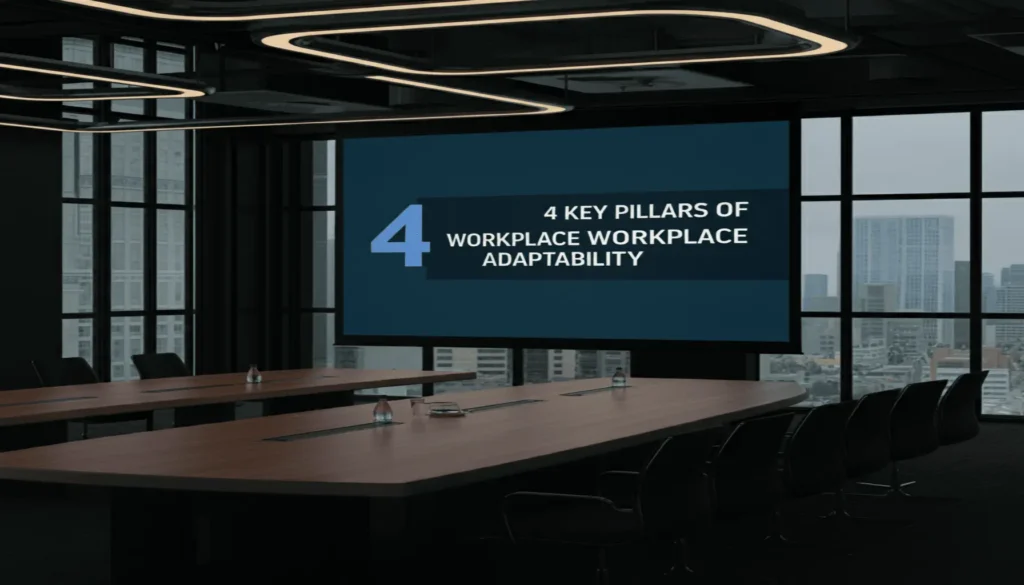
In our ever-evolving work landscape, adaptability isn’t just about rolling with the punches—it’s about thriving amidst change. To truly master adaptability in the workplace, we need to focus on four essential pillars. These pillars form the foundation of a highly adaptable professional, capable of navigating any challenge that comes their way.
Let’s dive into each pillar and explore how you can strengthen them to boost your adaptability quotient.
Cultivating a Growth Mindset for Continuous Learning
At the heart of adaptability lies the growth mindset—a belief that your abilities and intelligence can be developed through dedication and hard work. This mindset is crucial for embracing change and viewing challenges as opportunities for growth.
Importance of a Positive Attitude Towards Change and Learning
- Embraces challenges as opportunities to learn and grow
- Increases resilience in the face of setbacks
- Fosters innovation and creativity
- Enhances overall job satisfaction and engagement
Tips for Developing a Growth Mindset
- Embrace challenges: View difficult tasks as opportunities to stretch your abilities.
- Learn from criticism: See feedback as a tool for improvement, not a personal attack.
- Celebrate others’ successes: Instead of feeling threatened, find inspiration in others’ achievements.
- Use the power of “yet”: When facing a difficulty, add “yet” to your statements. “I can’t do this… yet.”
- Set learning goals: Focus on mastering new skills rather than just performing well.
To visualize the difference between a fixed and growth mindset, consider this comparison:
| Aspect | Fixed Mindset | Growth Mindset |
| Challenges | Avoids challenges | Embraces challenges |
| Obstacles | Gives up easily | Persists in the face of setbacks |
| Effort | Views effort as fruitless | Sees effort as the path to mastery |
| Criticism | Ignores useful negative feedback | Learns from criticism |
| Success of Others | Feels threatened by others’ success | Finds lessons and inspiration in others’ success |
Emotional intelligence (EQ) is the ability to understand, use, and manage your own emotions in positive ways to relieve stress, communicate effectively, empathize with others, overcome challenges and defuse conflict. In the context of adaptability, EQ is your secret weapon for navigating uncertain and challenging situations with grace.
Role of Self-Awareness, Empathy, and Emotional Regulation
- Self-awareness: Recognizing your emotions and their impact on your thoughts and behavior
- Empathy: Understanding and sharing the feelings of others
- Emotional regulation: Managing your emotions, especially in stressful situations
Strategies for Improving Emotional Intelligence
- Practice mindfulness: Regular meditation can improve self-awareness and emotional regulation.
- Keep an emotion journal: Track your emotions and the situations that trigger them.
- Seek feedback: Ask trusted colleagues about your emotional responses and interactions.
- Active listening: Focus on understanding others’ perspectives without immediately judging or responding.
- Develop empathy: Try to put yourself in others’ shoes in various situations.
Here’s a simple diagram to illustrate the components of emotional intelligence:
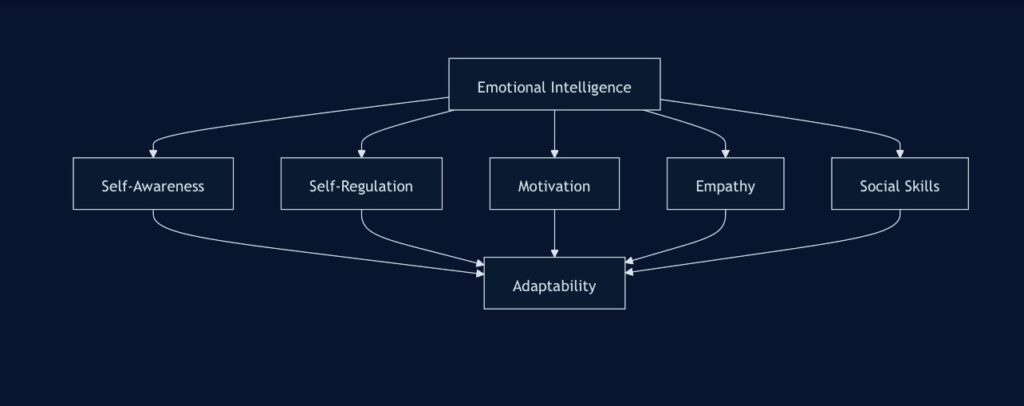
Honing Problem-Solving Skills to Seize Opportunities
In an adaptable workplace, every challenge is an opportunity in disguise. Developing strong problem-solving skills allows you to not only navigate difficulties but also uncover hidden potential in every situation.
Importance of Critical Thinking and Creative Problem-Solving
- Enables you to analyze complex situations from multiple angles
- Helps in identifying innovative solutions to unprecedented challenges
- Enhances decision-making abilities, especially under pressure
- Fosters a proactive approach to potential issues
Techniques for Enhancing Problem-Solving Abilities
- Practice the 5 Whys: Ask “why” five times to get to the root of a problem.
- Use mind mapping: Visually organize information to see connections and generate ideas.
- Implement design thinking: Approach problems with empathy, ideation, and experimentation.
- Try the Six Thinking Hats: Look at problems from different perspectives (facts, emotions, risks, benefits, creativity, process).
- Encourage brainstorming: Generate multiple ideas without judgment before evaluating them.
Building Strong Communication and Collaboration Skills for Teamwork
In our interconnected workplaces, the ability to communicate effectively and collaborate seamlessly is crucial for adaptability. These skills enable teams to navigate change together, pooling diverse perspectives and strengths.
Role of Effective Communication and Teamwork in Adapting to Change
- Facilitates the sharing of ideas and concerns during periods of transition
- Enables quick dissemination of important information
- Fosters a supportive environment where team members can lean on each other
- Allows for the coordination of efforts in responding to new challenges
Practical Advice for Improving Communication and Collaboration Skills
- Practice active listening: Focus on understanding, not just responding.
- Use the STAR method: When communicating ideas or experiences, use Situation, Task, Action, Result framework for clarity.
- Embrace diverse communication styles: Recognize and adapt to different communication preferences within your team.
- Utilize collaboration tools: Familiarize yourself with digital platforms that facilitate teamwork.
- Encourage open dialogue: Create an environment where all team members feel comfortable sharing ideas and concerns.
To visualize the impact of strong communication and collaboration on adaptability, consider this diagram:
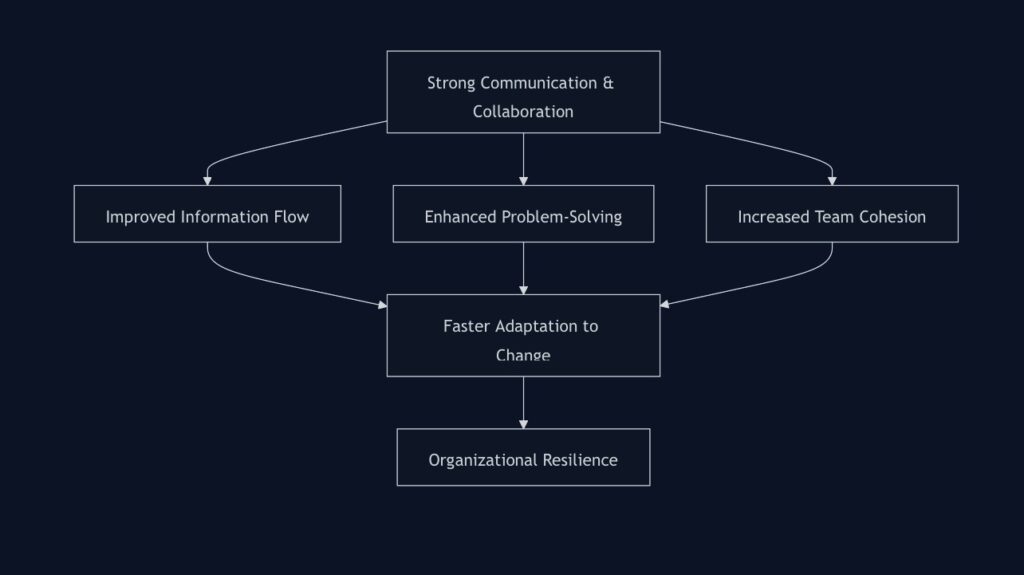
By focusing on these four pillars—growth mindset, emotional intelligence, problem-solving skills, and communication and collaboration—you’ll be well-equipped to navigate the ever-changing landscape of the modern workplace. Remember, adaptability is a skill that can be developed and honed over time. With consistent effort and practice in these areas, you’ll find yourself not just surviving but thriving in the face of change.
Common Challenges to Workplace Adaptability
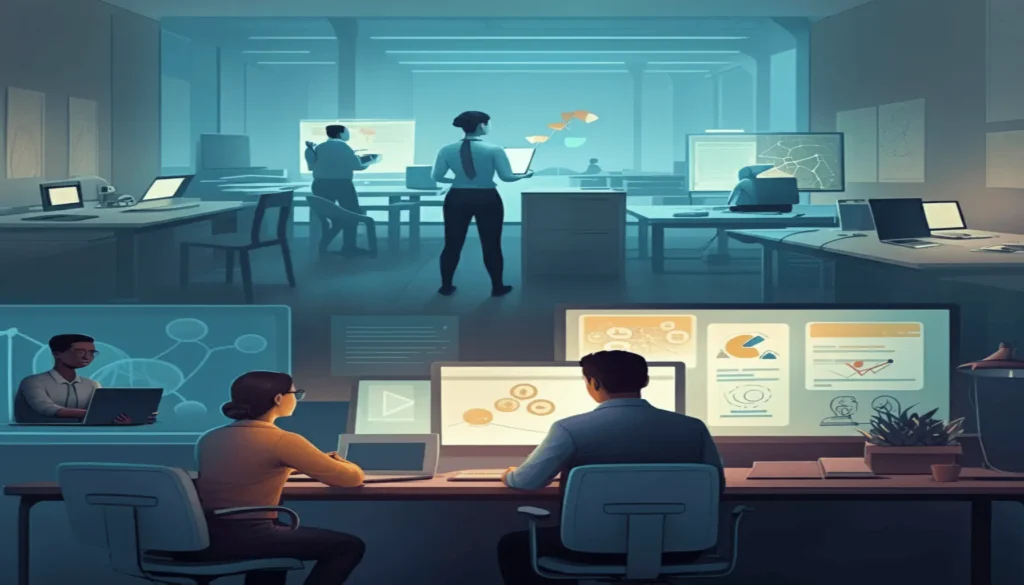
While the benefits of adaptability in the workplace are clear, many individuals and organizations struggle to embrace change. Understanding these challenges is the first step towards overcoming them. Let’s explore the most common barriers to workplace adaptability and how to address them.
Fear of Change
Fear of change is perhaps the most significant obstacle to adaptability. It’s a natural human response, but it can be paralyzing in a professional context.
Key aspects:
- Uncertainty about the future
- Worry about job security
- Anxiety about learning new skills or processes
How to overcome:
- Encourage open communication about upcoming changes
- Provide clear information and support during transitions
- Frame changes as opportunities for growth rather than threats
Comfort with Routine
Many people find comfort in familiar routines and may resist changes that disrupt their established ways of working.
Key aspects:
- Preference for predictability
- Reluctance to leave the “comfort zone”
- Habit-driven behavior
How to overcome:
- Gradually introduce changes to minimize disruption
- Highlight the benefits of new processes or technologies
- Encourage small, regular changes to build adaptability muscles
Lack of Confidence
A lack of confidence can make individuals hesitant to adapt, fearing they won’t be able to meet new challenges.
Key aspects:
- Self-doubt about abilities
- Imposter syndrome
- Fear of failure
How to overcome:
- Provide training and support for new skills
- Celebrate small wins and progress
- Foster a culture that views mistakes as learning opportunities
Limited Skill Set
Sometimes, the challenge isn’t willingness to adapt, but a lack of necessary skills to do so effectively.
Key aspects:
- Outdated technical skills
- Underdeveloped soft skills (e.g., communication, problem-solving)
- Lack of diverse experiences
How to overcome:
- Invest in continuous learning and development programs
- Encourage cross-functional projects and job rotations
- Provide mentoring and coaching opportunities
Rigid Organizational Culture
An organization’s culture can either foster or hinder adaptability. Rigid cultures often present significant barriers to change.
Key aspects:
- “We’ve always done it this way” mentality
- Hierarchical decision-making processes
- Lack of innovation incentives
How to overcome:
- Lead by example, with leadership embracing change
- Reward innovative thinking and calculated risk-taking
- Flatten hierarchies and encourage bottom-up innovation
Resistance from Colleagues
Even when an individual is ready to adapt, resistance from team members or colleagues can be a significant hurdle.
Key aspects:
- Peer pressure to maintain status quo
- Lack of team cohesion
- Conflicting priorities among team members
How to overcome:
- Foster a collaborative environment
- Encourage open dialogue about changes
- Align team goals with adaptability objectives
To better understand these challenges and their impact, let’s look at a comparison table:
| Challenge | Impact on Individual | Impact on Organization | Potential Solutions |
| Fear of Change | Stress, reduced productivity | Slow adoption of new processes | Change management training, clear communication |
| Comfort with Routine | Resistance to new methods | Stagnation, missed opportunities | Gradual introduction of changes, highlighting benefits |
| Lack of Confidence | Hesitation to take on new roles | Underutilized talent | Mentoring programs, skill development workshops |
| Limited Skill Set | Difficulty adapting to new technologies | Reduced competitiveness | Continuous learning initiatives, cross-training |
| Rigid Organizational Culture | Frustration, decreased motivation | Innovation barriers, talent loss | Leadership development, cultural transformation programs |
| Resistance from Colleagues | Interpersonal conflicts, team dysfunction | Decreased collaboration, slower project completion | Team-building activities, align individual and team goals |
To visualize how these challenges interrelate and impact adaptability, consider this diagram:
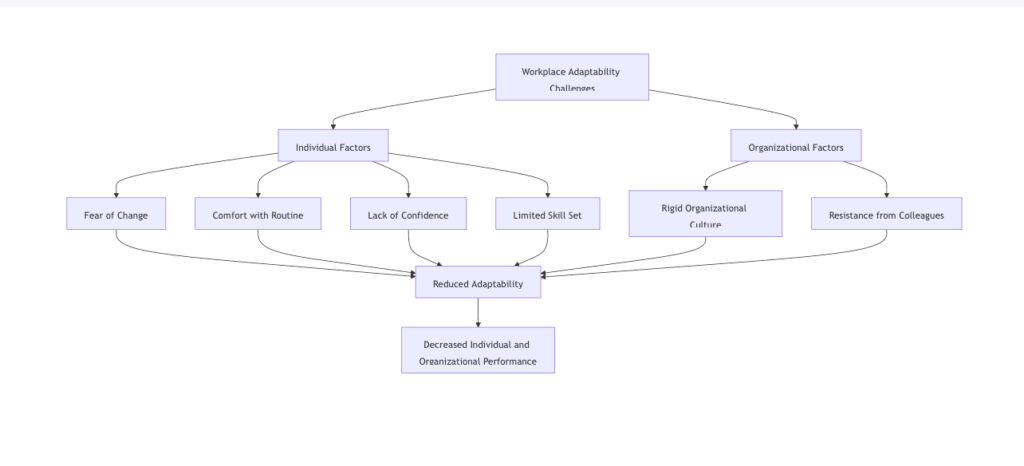
Case Study: Overcoming Adaptability Challenges
Let’s look at how a real company tackled these challenges. Kodak, once a giant in the photography industry, famously struggled with adaptability. Despite inventing the first digital camera, the company’s comfort with its existing business model and fear of cannibalizing its film business led to its downfall.
In contrast, Fujifilm, facing the same industry disruption, successfully adapted by:
- Addressing fear of change through clear communication about the need for transformation
- Overcoming comfort with routine by gradually diversifying into new industries
- Building confidence and skills through investment in R&D and employee training
- Transforming organizational culture to embrace innovation and calculated risk-taking
Fujifilm’s successful adaptation demonstrates that with the right strategies, even the most significant challenges to workplace adaptability can be overcome.
By understanding and actively addressing these common challenges, both individuals and organizations can cultivate a more adaptable workplace culture. This not only ensures survival in times of change but also drives innovation and growth in an ever-evolving business landscape.
How to Develop Adaptability in the Workplace: A Practical Guide

In today’s rapidly evolving work environment, developing adaptability isn’t just an option—it’s a necessity. This practical guide will walk you through six key strategies to enhance your adaptability, helping you thrive in any workplace situation.
Identifying Your Adaptability Strengths and Weaknesses
Before you can improve your adaptability, you need to know where you stand. Here are some effective self-assessment tools and techniques:
- The Adaptability Quotient (AQ) Assessment: This online test measures your ability to adapt to change and uncertainty.
- SWOT Analysis: Create a personal SWOT (Strengths, Weaknesses, Opportunities, Threats) analysis focused on your adaptability skills.
- 360-Degree Feedback: Ask colleagues, supervisors, and subordinates for feedback on your adaptability in various situations.
- Reflective Journaling: Keep a journal of how you respond to changes at work, noting patterns in your reactions and behaviors.
Here’s a simple template for a personal adaptability SWOT analysis:
| Strengths | Opportunities | Weaknesses | Threats |
| • Quick learner • Open to feedback • Comfortable with technology | • New projects to expand skills • Mentorship programs • Online courses in emerging technologies | • Struggle with sudden changes • Prefer routine • Difficulty with ambiguity | • Rapid industry changes • Automation of current tasks • Increased competition in job market |
Seeking Out Opportunities for Growth and Learning
Once you’ve identified areas for improvement, actively seek opportunities to grow:
- Embrace New Challenges and Projects:
- Volunteer for cross-functional projects
- Take on tasks outside your comfort zone
- Propose innovative solutions to existing problems
- Seek Mentorship and Professional Development:
- Find a mentor in your industry or organization
- Join professional associations related to your field
- Attend conferences and networking events
- Participate in online communities related to your industry
Read also : Online Communities: Growing, Thriving in Digital Age
Practicing Mindfulness and Stress Management Techniques
Adaptability often requires managing stress and staying grounded during change:
- Mindfulness for Staying Grounded During Change:
- Stress Management Strategies for Improved Resilience:
- Regular exercise and physical activity
- Adequate sleep and nutrition
- Time management techniques like the Pomodoro method
- Practice gratitude journaling
Commit to Lifelong Learning and Skill Enhancement
In a rapidly changing workplace, continuous learning is crucial:
- Identifying Skill Gaps and Pursuing Relevant Training:
- Regularly review job postings in your field to identify trending skills
- Conduct informational interviews with industry leaders
- Use LinkedIn Learning or Coursera to take courses in emerging areas
- Embracing Microlearning and Cross-Training Opportunities:
Enhance Flexibility and Open-Mindedness
Adaptability requires a flexible mindset and openness to new ideas:
- Practicing Active Listening and Considering Diverse Perspectives:
- Use the “RASA” technique: Receive, Appreciate, Summarize, Ask
- Seek out opinions different from your own
- Participate in diversity and inclusion workshops
- Adapting Communication Styles for Different Audiences:
- Learn about communication models like DISC
- Practice adjusting your communication style based on your audience
- Seek feedback on your communication effectiveness
Improve Problem-Solving and Decision-Making Skills Under Pressure
Adaptable individuals excel at solving problems and making decisions in challenging situations:
- Scenario Planning and Contingency Thinking:
- Regularly engage in “what-if” scenarios for your projects
- Develop contingency plans for potential obstacles
- Use tools like decision trees for complex decisions
- Decision-Making Exercises and Simulations:
- Practice with online decision-making games or simulations
- Participate in role-playing exercises with colleagues
- Use frameworks like the Eisenhower Matrix for prioritizing decisions
To visualize the process of developing adaptability, consider this flowchart:
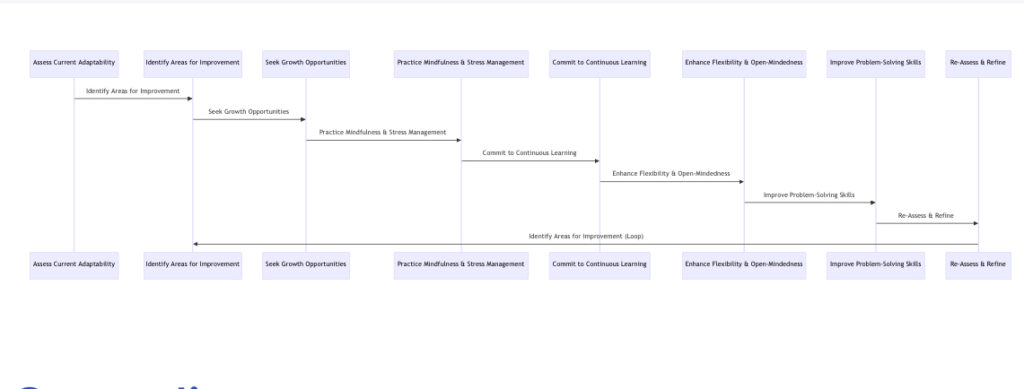
Remember, developing adaptability is an ongoing process. Regularly revisit these strategies and adjust your approach as needed. By consistently working on these areas, you’ll build the adaptability muscles needed to thrive in today’s dynamic workplace.
Adaptability in Different Work Environments

Adaptability isn’t one-size-fits-all. The skills and strategies needed can vary significantly depending on your work environment. Let’s explore how adaptability manifests in different settings and industries, and how you can thrive in each.
Adaptability in Remote Work
The rise of remote work has brought unique challenges and opportunities for adaptability. Here’s how to navigate this digital landscape:
Unique Challenges and Opportunities
- Challenges:
- Maintaining work-life balance
- Combating isolation and loneliness
- Managing distractions at home
- Overcoming communication barriers
- Opportunities:
- Increased flexibility in work hours
- Potential for improved productivity
- Access to a global job market
- Reduced commute stress and costs
Tips for Staying Connected and Productive
- Establish a Dedicated Workspace: Create a home office setup that mimics a professional environment.
- Maintain Regular Communication: Use video calls, instant messaging, and project management tools to stay connected with your team.
- Set Clear Boundaries: Define work hours and communicate them to both colleagues and family members.
- Embrace Digital Tools: Familiarize yourself with remote work technologies to enhance collaboration and productivity.
- Practice Self-Care: Incorporate regular breaks, exercise, and social interactions to maintain mental health.
Adaptability in Fast-Paced Industries
Rapid change is the norm in many sectors. Here’s how to keep up: Strategies for Thriving in Rapidly Changing Sectors:
- Stay Informed: Regularly read industry publications and attend conferences to keep abreast of trends.
- Develop a Learning Mindset: Embrace continuous learning and be open to new ideas and technologies.
- Build a Strong Network: Cultivate relationships with colleagues and mentors who can provide support and insights.
- Practice Agile Methodologies: Adopt agile principles in your work to respond quickly to changes.
- Anticipate Change: Try to predict future trends and prepare for potential shifts in your industry.
Adaptability in Traditional vs. Modern Workplaces
Navigating different cultures of change requires a nuanced approach. Let’s compare:
| Aspect | Traditional Workplace | Modern Workplace |
| Structure | Hierarchical | Flat or matrix |
| Communication | Formal, often top-down | Open, multi-directional |
| Decision-making | Centralized | Collaborative |
| Work arrangements | Fixed hours, office-based | Flexible hours, hybrid or remote options |
| Technology adoption | Often slower, resistant to change | Rapid, embraces new tech |
| Career paths | Linear, predetermined | Non-linear, self-directed |
Navigating Different Cultures of Change:
- Understand the Culture: Observe and learn the unwritten rules and values of your workplace.
- Be a Bridge: If you’re comfortable with change, help others adapt by sharing your strategies and offering support.
- Respect Tradition While Embracing Innovation: In traditional settings, introduce change gradually and respect established processes.
- Advocate for Positive Change: In any environment, be prepared to make a case for beneficial adaptations.
- Develop Versatility: Cultivate skills that allow you to thrive in both traditional and modern workplace cultures.
Adaptability in Specific Industries
Different sectors require unique adaptability skills. Let’s explore four key industries:

Technology Sector
- Key Adaptability Challenges:
- Rapid technological advancements
- Evolving programming languages and frameworks
- Shifting consumer preferences
- Adaptability Strategies:
- Engage in continuous learning (e.g., online tech courses)
- Participate in open-source projects to broaden skills
- Stay updated with industry news and trends
- Develop soft skills alongside technical expertise
Healthcare Industry
- Key Adaptability Challenges:
- Changing regulations and policies
- Integration of new medical technologies
- Shift towards patient-centered care models
- Adaptability Strategies:
- Pursue ongoing professional development and certifications
- Embrace telemedicine and digital health tools
- Develop strong communication skills for patient education
- Practice interdisciplinary collaboration
Education Field
- Key Adaptability Challenges:
- Transition to online and hybrid learning models
- Integration of educational technology
- Addressing diverse learning needs
- Adaptability Strategies:
- Experiment with innovative teaching methods
- Develop digital literacy skills
- Engage in professional learning communities
- Foster a growth mindset in both yourself and your students
Finance Sector
- Key Adaptability Challenges:
- Market volatility and economic uncertainties
- Fintech disruption and digital transformation
- Evolving regulatory landscape
- Adaptability Strategies:
- Stay informed about global economic trends
- Develop skills in data analytics and AI applications in finance
- Cultivate emotional intelligence to manage stress and client relationships
- Embrace sustainable and ethical finance practices
By understanding the unique adaptability requirements of different work environments and industries, you can tailor your approach and develop the specific skills needed to thrive. Remember, the key to adaptability is a willingness to learn, an openness to change, and the resilience to face new challenges head-on.
Tools and Technologies for Enhancing Workplace Adaptability
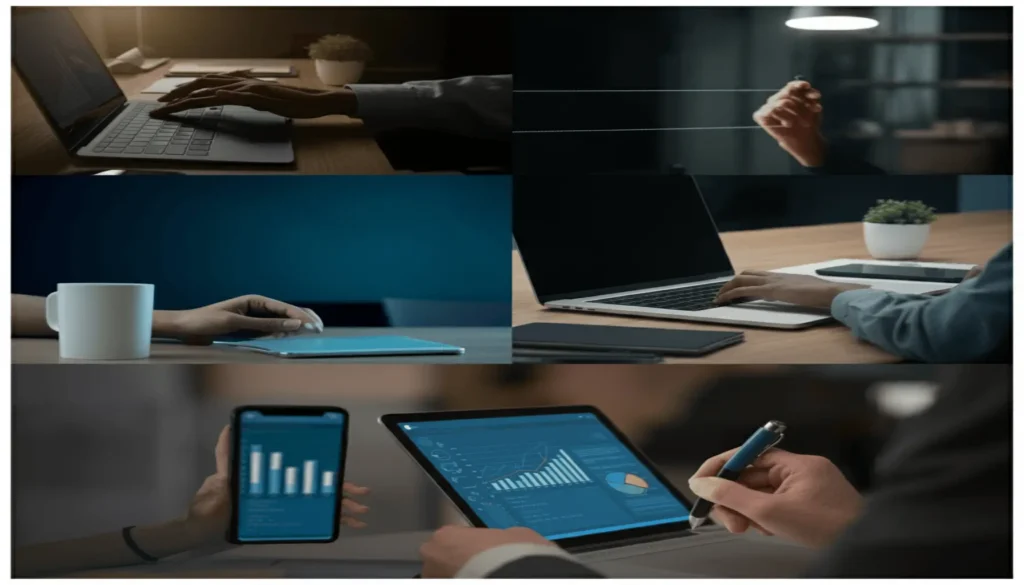
In our digital age, leveraging the right tools and technologies can significantly boost your adaptability in the workplace. These digital allies can help you stay organized, collaborate effectively, learn continuously, and maintain your well-being—all crucial aspects of adaptability. Let’s explore some of the most impactful tools in each category:
Project Management Software
Project management tools are the backbone of adaptable work environments, allowing teams to pivot quickly and stay on top of changing priorities.
Key Features for Adaptability:
- Real-time updates and notifications
- Flexible task assignment and reassignment
- Visual project tracking (e.g., Kanban boards, Gantt charts)
- Integration with other workplace tools
Popular Options:
- Trello: Great for visual organization and quick adaptations
- Asana: Offers multiple project views and workflow automation
- Jira: Ideal for agile teams and complex projects
Adaptability Tip: Regularly review and adjust your project management setup to ensure it’s meeting your evolving needs.
Collaboration Platforms
These platforms are the digital equivalent of adaptable workspaces, allowing teams to communicate and collaborate regardless of location or time zone.
Key Features for Adaptability:
- Real-time messaging and video conferencing
- File sharing and co-editing capabilities
- Virtual whiteboards for brainstorming
- Customizable workspaces and channels
Popular Options:
- Slack: Excellent for quick communication and integrations
- Microsoft Teams: Robust option for Microsoft-centric organizations
- Zoom: Primarily for video conferencing, but expanding collaboration features
Adaptability Tip: Experiment with different features and integrations to find the most effective setup for your team’s communication style.
Learning Management Systems (LMS)
An LMS can be your personal adaptability trainer, helping you acquire new skills and knowledge as your role evolves.
Key Features for Adaptability:
- Personalized learning paths
- Progress tracking and skill assessments
- Diverse content formats (video, text, interactive)
- Social learning features
Popular Options:
- LinkedIn Learning: Broad range of professional skills courses
- Coursera: Partnership with universities for in-depth learning
- Udemy: Diverse course offerings, many created by industry professionals
Adaptability Tip: Set aside regular time for learning and align your courses with both current needs and future career aspirations.
Productivity Apps
These tools help you adapt your work habits for maximum efficiency, crucial for managing changing workloads and priorities.
Key Features for Adaptability:
- Task prioritization and time tracking
- Focus modes and distraction blockers
- Cross-device synchronization
- AI-powered suggestions and automation
Popular Options:
- Todoist: Powerful to-do list app with natural language input
- RescueTime: Automatic time-tracking and productivity insights
- Notion: All-in-one workspace for notes, tasks, and databases
Adaptability Tip: Regularly review your productivity data and adjust your tools and habits accordingly.
Mindfulness and Meditation Apps
Mental resilience is a key component of adaptability. These apps help you maintain focus, reduce stress, and improve emotional regulation.
Key Features for Adaptability:
- Guided meditations for various situations
- Breathing exercises
- Sleep stories and relaxation techniques
- Mood tracking and mindfulness reminders
Popular Options:
- Headspace: Structured courses and daily meditations
- Calm: Wide variety of calming audio content
- Insight Timer: Large library of free meditations and live events
Adaptability Tip: Integrate short mindfulness practices into your daily routine to build resilience over time.
To visualize how these tools contribute to workplace adaptability, consider this diagram:
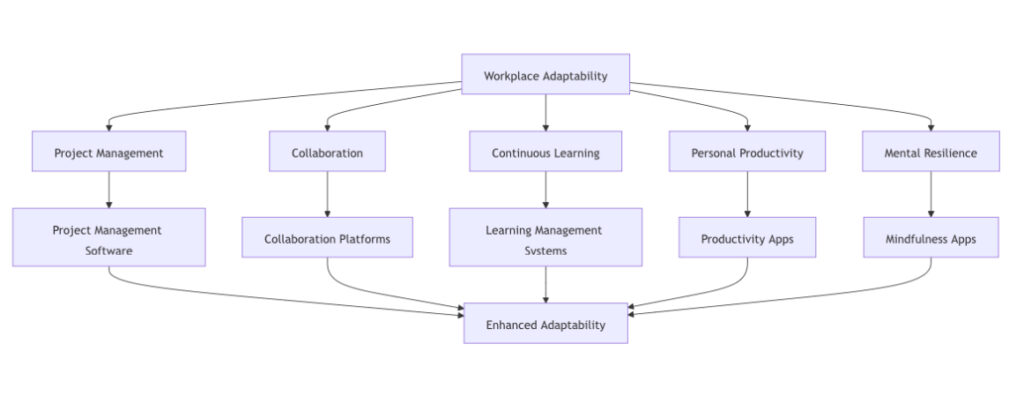
Comparing Tool Categories for Adaptability
Here’s a quick comparison of how each tool category contributes to different aspects of workplace adaptability:
| Tool Category | Task Flexibility | Communication | Skill Development | Personal Efficiency | Stress Management |
| Project Management Software | ★★★★★ | ★★★☆☆ | ★☆☆☆☆ | ★★★★☆ | ★★☆☆☆ |
| Collaboration Platforms | ★★★☆☆ | ★★★★★ | ★★☆☆☆ | ★★★☆☆ | ★☆☆☆☆ |
| Learning Management Systems | ★☆☆☆☆ | ★★☆☆☆ | ★★★★★ | ★★☆☆☆ | ★★☆☆☆ |
| Productivity Apps | ★★★★☆ | ★☆☆☆☆ | ★★☆☆☆ | ★★★★★ | ★★★☆☆ |
| Mindfulness Apps | ★☆☆☆☆ | ★☆☆☆☆ | ★★☆☆☆ | ★★★☆☆ | ★★★★★ |
Remember, the key to enhancing adaptability through technology is not just having these tools, but using them effectively and consistently. Regularly assess your needs and adjust your digital toolkit accordingly. By mastering these technologies, you’ll be better equipped to navigate the ever-changing landscape of the modern workplace with confidence and agility.
Read also : Master Project Management Tools: 2024 Expert Guide
The Role of Leadership in Fostering Adaptability

In the quest for a more adaptable workplace, leadership plays a pivotal role. Leaders set the tone, shape the culture, and provide the resources necessary for adaptability to flourish. Let’s explore how effective leaders can cultivate an environment where adaptability thrives.
Creating a Culture of Adaptability
Leaders are the architects of organizational culture. To foster adaptability, they need to intentionally build a culture that embraces change and values flexibility. Here’s how:
- Promote a Growth Mindset: Encourage employees to view challenges as opportunities for learning and growth.
- Example: Microsoft’s CEO Satya Nadella transformed the company’s culture by promoting a “learn-it-all” rather than a “know-it-all” mindset.
- Celebrate Adaptability: Recognize and reward employees who demonstrate adaptability in their work.
- Tip: Implement an “Adaptability Champion” award in your regular recognition programs.
- Normalize Change: Regularly introduce small changes to help employees become comfortable with flux.
- Example: Rotate team meeting facilitators or periodically reorganize office layouts.
- Foster Psychological Safety: Create an environment where employees feel safe to take risks, make mistakes, and voice their ideas.
- Resource: Google’s Project Aristotle found psychological safety to be the most critical factor in high-performing teams.
Leadership Practices that Promote Innovation and Collaboration
Adaptable organizations are often hotbeds of innovation and collaboration. Leaders can nurture these qualities through specific practices:
- Encourage Cross-Functional Collaboration: Break down silos and promote interaction between different departments.
- Idea: Implement “Innovation Days” where employees from different teams work together on new projects.
- Embrace Diverse Perspectives: Actively seek out and value different viewpoints in decision-making processes.
- Tip: Use techniques like Edward de Bono’s Six Thinking Hats in meetings to encourage diverse thinking.
- Promote Design Thinking: Teach and use design thinking methodologies to approach problem-solving creatively.
- Resource: IDEO U’s Design Thinking course can be a valuable tool for leaders and teams.
- Implement Agile Methodologies: Adopt agile principles beyond software development to increase organizational flexibility.
- Example: ING Bank’s agile transformation led to increased efficiency and employee engagement.
Providing Resources and Support for Skill Development
Leaders must ensure their teams have the tools and opportunities to develop adaptability skills:
- Allocate Learning Budgets: Provide financial resources for employees to pursue relevant courses and certifications.
- Tip: Offer a yearly learning stipend that employees can use flexibly for their development.
- Create Internal Learning Platforms: Develop in-house training programs focused on adaptability and related skills.
- Example: AT&T’s $1 billion retraining program aimed at future-proofing their workforce.
- Encourage Skill Sharing: Facilitate peer-to-peer learning through mentorship programs or skill-sharing sessions.
- Idea: Implement a “Teach Me Tuesday” where employees share skills in brief, informal sessions.
- Provide Time for Learning: Allow dedicated time during work hours for skill development.
- Example: Google’s famous “20% time” policy encourages employees to spend time on personal projects, fostering innovation and skill development.
Leading by Example
Leaders must embody the adaptability they wish to see in their organizations:
- Demonstrate Continuous Learning: Openly share your own learning journey and new skills you’re developing.
- Tip: Start team meetings by sharing a new insight or skill you’ve recently acquired.
- Admit Mistakes and Share Lessons: Be transparent about your failures and what you’ve learned from them.
- Example: Coca-Cola’s CEO James Quincey openly discussed the failure of New Coke and the lessons learned, setting a tone of openness and learning from mistakes.
- Embrace Change Enthusiastically: Approach organizational changes with positivity and energy.
- Idea: When announcing changes, focus on the opportunities they present rather than the challenges.
- Seek and Act on Feedback: Regularly ask for feedback from your team and visibly implement changes based on it.
- Tool: Use 360-degree feedback tools to gather comprehensive insights about your leadership style.
Encouraging Calculated Risk-Taking
To foster adaptability, leaders need to create an environment where calculated risks are encouraged:
- Reframe Failure: View and discuss failures as learning opportunities rather than disasters.
- Example: Tata Group’s Dare to Try award celebrates bold attempts that didn’t succeed, encouraging risk-taking.
- Provide Safe Spaces for Experimentation: Create low-stakes environments where employees can test new ideas.
- Idea: Implement “innovation sandboxes” where teams can experiment with new processes or technologies without impacting core operations.
- Set Clear Risk Parameters: Clearly communicate what constitutes acceptable risk in your organization.
- Tool: Develop a risk assessment matrix tailored to your organization’s risk tolerance.
- Celebrate Bold Moves: Recognize employees who take smart risks, regardless of the outcome.
- Tip: Share stories of calculated risks across the organization, highlighting the learning process.
To visualize how these leadership practices interconnect to foster adaptability, consider this diagram:
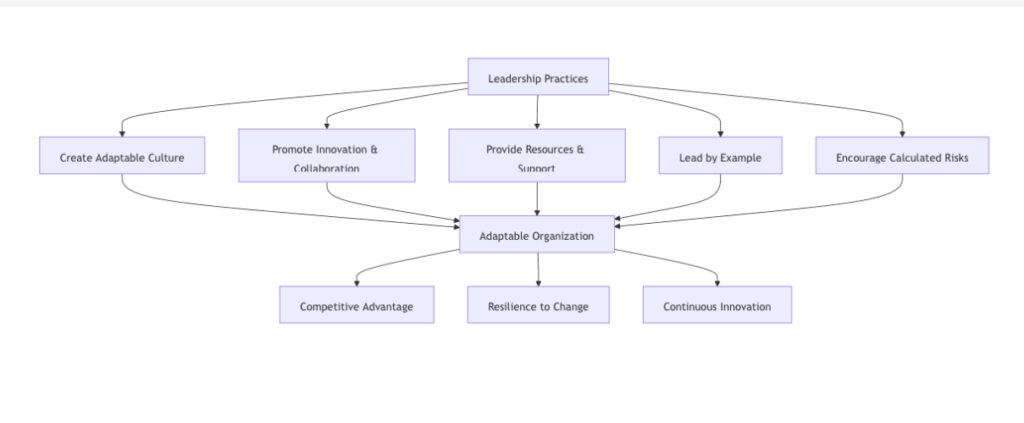
By implementing these leadership practices, organizations can create an environment where adaptability flourishes. Remember, fostering adaptability is an ongoing process that requires consistent effort and commitment from leaders at all levels. As the business landscape continues to evolve, adaptable organizations led by adaptable leaders will be best positioned to thrive in the face of change.
Measuring and Assessing Adaptability in the Workplace

In today’s dynamic work environment, adaptability isn’t just a buzzword—it’s a critical skill that can make or break careers and organizations. But how do we move beyond simply recognizing its importance to actually measuring and assessing it? Let’s dive into some practical approaches to quantify and evaluate adaptability in the workplace.
Key Performance Indicators (KPIs) for Adaptability
Measuring adaptability can be tricky, as it’s often seen as a soft skill. However, by focusing on specific behaviors and outcomes, we can develop meaningful KPIs. Here are some examples:
- Learning Agility Index
- Measure: Number of new skills acquired or certifications earned per year
- Goal: Encourage continuous learning and skill development
- Change Response Time
- Measure: Average time taken to implement new processes or technologies
- Goal: Assess how quickly employees adapt to organizational changes
- Innovation Metric
- Measure: Number of new ideas or improvements suggested and implemented
- Goal: Evaluate employees’ ability to think creatively and drive positive change
- Cross-functional Collaboration Score
- Measure: Frequency and effectiveness of work on cross-departmental projects
- Goal: Assess adaptability in working with diverse teams and perspectives
- Problem-solving Efficiency
- Measure: Time taken to resolve unexpected issues or challenges
- Goal: Evaluate ability to adapt to unforeseen circumstances
Here’s a simple scorecard template for tracking these KPIs:
| KPI | Measurement Method | Target | Q1 | Q2 | Q3 | Q4 | YTD |
| Learning Agility Index | # of new skills/certifications | 4/year | |||||
| Change Response Time | Avg. implementation time (days) | 30 days | |||||
| Innovation Metric | # of ideas implemented | 2/quarter | |||||
| Cross-functional Collaboration Score | # of cross-dept projects | 3/year | |||||
| Problem-solving Efficiency | Avg. resolution time (hours) | 24 hours |
Self-Assessment Tools and Techniques
Encouraging employees to reflect on their own adaptability can be a powerful tool for growth. Here are some self-assessment approaches:
- Adaptability Quotient (AQ) Test
- Similar to IQ or EQ tests, AQ assessments measure an individual’s adaptability
- Example: The AQai Assessment provides insights into different dimensions of adaptability
- SWOT Analysis for Adaptability
- Employees can assess their Strengths, Weaknesses, Opportunities, and Threats related to adaptability
- This helps identify areas for improvement and potential growth opportunities
- Adaptability Journal
- Encourage employees to keep a journal documenting how they’ve adapted to changes or challenges
- This promotes self-reflection and helps track progress over time
- Scenario-Based Self-Assessment
- Present hypothetical workplace scenarios and ask employees to describe how they would respond
- This can reveal adaptability strengths and areas for development
Here’s a simple self-assessment questionnaire template:
Rate yourself on a scale of 1-5 (1 = Strongly Disagree, 5 = Strongly Agree):
- I quickly adjust to new work processes or technologies: ___
- I remain calm and focused when faced with unexpected challenges: ___
- I actively seek out opportunities to learn new skills: ___
- I’m comfortable working with people from diverse backgrounds and perspectives: ___
- I can easily shift priorities when project goals change: ___
Total Score: ___ / 25
360-Degree Feedback Approaches
To get a comprehensive view of an employee’s adaptability, it’s valuable to gather feedback from various sources. A 360-degree approach might include:
- Peer Feedback
- Colleagues can provide insights into how an individual adapts in team settings
- Manager Assessments
- Direct supervisors can evaluate adaptability in relation to job performance and goals
- Subordinate Input
- For those in leadership positions, feedback from direct reports can reveal adaptability in management style
- Client or Stakeholder Feedback
- External perspectives can provide valuable insights into adaptability in client-facing roles
- Self-Evaluation
- The employee’s own assessment, to be compared with other perspectives
Here’s a diagram illustrating the 360-degree feedback process:

Integrating Adaptability into Performance Evaluations
To truly emphasize the importance of adaptability, it should be incorporated into regular performance evaluations. Here’s how:
- Define Adaptability Competencies
- Clearly outline what adaptability looks like in your organization
- Example: “Demonstrates flexibility in approach to work, readily adjusts to changing priorities”
- Set Adaptability Goals
- Work with employees to set specific, measurable adaptability-related goals
- Example: “Complete two cross-departmental projects this year to broaden skillset”
- Regular Check-ins
- Discuss adaptability progress in one-on-one meetings throughout the year
- Use these conversations to provide support and resources for improvement
- Weighted Scoring
- Assign a specific weight to adaptability in overall performance scores
- This underscores its importance alongside other key competencies
- Adaptability Success Stories
- Encourage employees to document specific instances where they demonstrated adaptability
- These can be discussed and celebrated during evaluations
Remember, the goal of measuring and assessing adaptability isn’t to criticize or punish, but to foster a culture of continuous improvement and resilience. By implementing these strategies, organizations can not only track adaptability but actively cultivate it, creating a workforce that’s ready to thrive in an ever-changing business landscape.
The Connection Between Adaptability and Well-being

In our fast-paced, ever-changing work environment, the link between adaptability and personal well-being is becoming increasingly apparent. Let’s dive into how being adaptable can positively impact your mental and emotional health, help you manage stress, and why it’s crucial to balance adaptability with stability and self-care.
Impact of Adaptability on Mental and Emotional Well-being
Adaptability isn’t just a professional skill—it’s a powerful tool for maintaining and improving your mental and emotional health. Here’s how:
- Reduced Anxiety and Depression:
- Adaptable individuals are less likely to feel overwhelmed by change, reducing anxiety levels.
- The ability to adjust to new situations can prevent feelings of helplessness often associated with depression.
- A study in the Journal of Personality found that adaptability is positively associated with life satisfaction and negatively associated with depression.
- Increased Resilience:
- Adaptability builds mental toughness, helping you bounce back from setbacks more quickly.
- It fosters a sense of control over your environment, boosting self-esteem and confidence.
- Enhanced Emotional Intelligence:
- Adaptable people often have higher emotional intelligence, leading to better relationships at work and in personal life.
- They’re more attuned to their own emotions and those of others, facilitating better communication and empathy.
- Greater Sense of Purpose:
- Adaptability allows you to find meaning and opportunity in changing circumstances.
- It can lead to a more optimistic outlook on life and work, contributing to overall well-being.
To visualize the relationship between adaptability and well-being, consider this diagram:
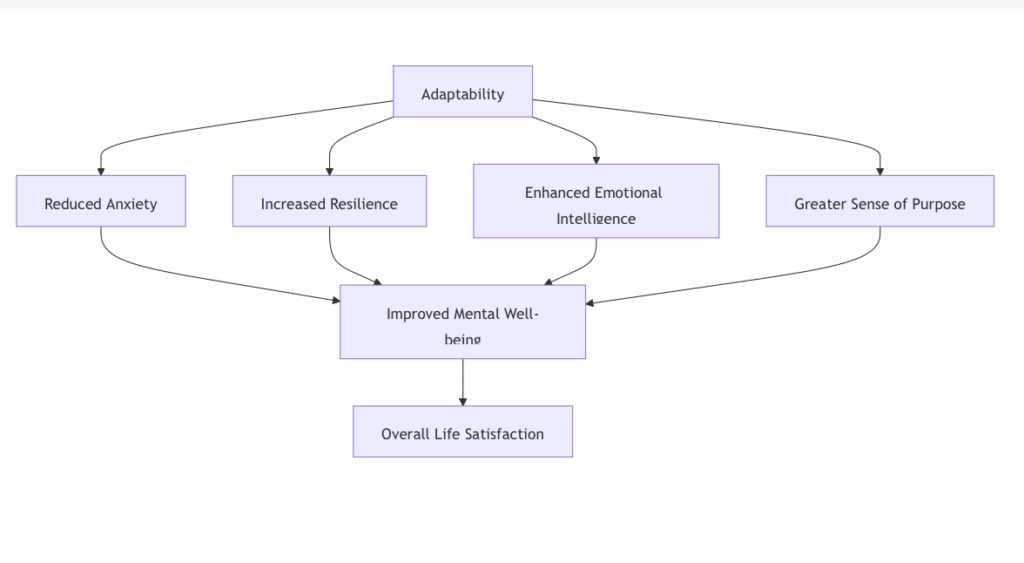
How Adaptability Helps Cope with Stress and Uncertainty
In today’s VUCA (Volatile, Uncertain, Complex, Ambiguous) world, adaptability is a crucial skill for managing stress and navigating uncertainty:
- Stress Reduction:
- Adaptable individuals view change as a challenge rather than a threat, reducing stress responses.
- They’re more likely to use problem-focused coping strategies, which are associated with better mental health outcomes.
- Uncertainty Management:
- Adaptability helps you become comfortable with ambiguity, reducing anxiety about the unknown.
- It allows for flexible thinking, helping you see multiple solutions to uncertain situations.
- Crisis Navigation:
- During times of crisis (like the COVID-19 pandemic), adaptable individuals are better equipped to adjust to new norms and find creative solutions.
- They’re more likely to maintain productivity and positive mental health even in challenging circumstances.
- Work-Life Integration:
- Adaptable people can better navigate the blurring lines between work and personal life, especially in remote or hybrid work environments.
- They’re more skilled at adjusting their routines to maintain a healthy work-life balance.
Let’s compare how adaptable and less adaptable individuals might respond to workplace stressors:
| Stressor | Adaptable Response | Less Adaptable Response |
| Sudden project deadline change | Quickly reprioritizes tasks and seeks help if needed | Becomes overwhelmed and stressed, potentially missing the deadline |
| New technology implementation | Sees it as an opportunity to learn and improve efficiency | Resists the change, leading to increased anxiety and potential performance issues |
| Organizational restructuring | Views it as a chance for new opportunities and growth | Feels threatened and insecure about their position |
| Remote work transition | Adjusts work habits and finds new ways to collaborate effectively | Struggles with the new format, leading to decreased productivity and job satisfaction |
Balancing Adaptability with Stability and Self-Care
While adaptability is crucial, it’s equally important to maintain a sense of stability and prioritize self-care. Here’s how to strike that balance:
- Establish Core Routines:
- Identify key routines that provide a sense of stability (e.g., morning meditation, regular exercise).
- Maintain these routines even as other aspects of work and life change.
- Set Boundaries:
- Be adaptable, but also know your limits. It’s okay to say no to requests that compromise your well-being.
- Establish clear work-life boundaries, especially when working remotely.
- Practice Mindfulness:
- Use mindfulness techniques to stay grounded during times of change.
- Regular mindfulness practice can improve your ability to adapt while maintaining inner calm.
- Prioritize Self-Care:
- Make time for activities that recharge you, such as hobbies, exercise, or spending time with loved ones.
- Remember that taking care of yourself enhances your ability to adapt to challenges.
- Seek Support:
- Don’t hesitate to reach out to colleagues, friends, or professionals when you need support.
- Consider joining support groups or professional networks to share experiences and coping strategies.
To help you maintain this balance, consider using a self-care checklist like this:
- Did I maintain my core routines today?
- Did I set and respect my boundaries?
- Did I practice mindfulness or meditation?
- Did I engage in a self-care activity?
- Did I connect with my support network?
By checking in with yourself regularly using tools like this, you can ensure that you’re adapting to workplace demands without sacrificing your well-being.
Remember, the goal is not to be infinitely adaptable at the expense of your health and happiness. Instead, aim to develop a flexible resilience that allows you to thrive in changing environments while maintaining a strong sense of self and well-being. By striking this balance, you’ll be well-equipped to navigate the challenges of the modern workplace while fostering a fulfilling and healthy life.
Future Trends in Workplace Adaptability
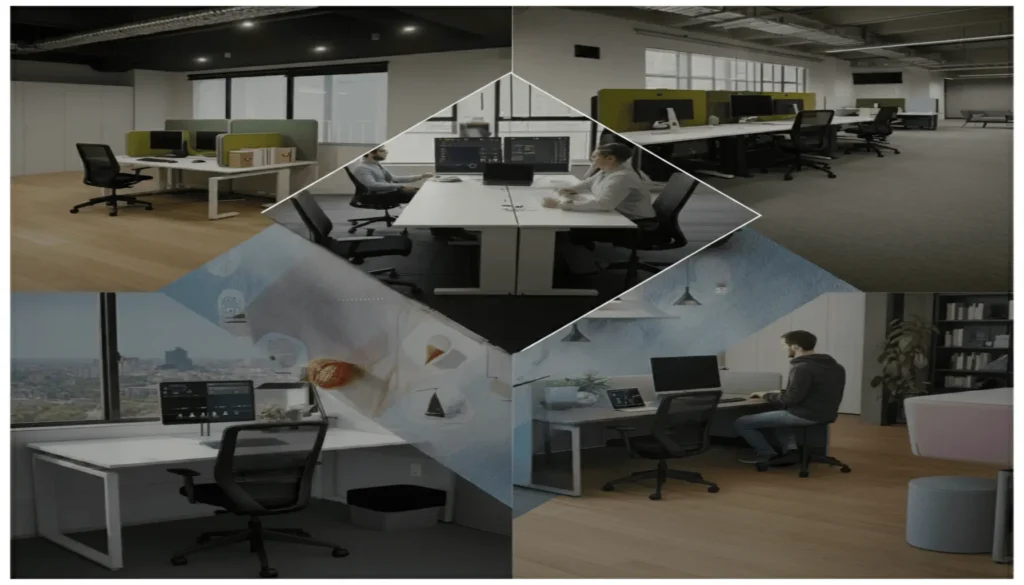
As we peer into the future of work, it’s clear that adaptability will continue to be a critical skill. The workplace is evolving at an unprecedented pace, driven by technological advancements, changing social norms, and global events. Let’s explore the key trends that will shape the future of adaptability in the workplace.
Impact of AI and Automation on Adaptability Needs
Artificial Intelligence (AI) and automation are revolutionizing the way we work, creating both challenges and opportunities for workplace adaptability.

- Skill Shift: As AI takes over routine tasks, workers will need to adapt by focusing on skills that complement AI, such as creative thinking, emotional intelligence, and complex problem-solving.
- Continuous Learning: The rapid evolution of AI will require workers to constantly update their knowledge and skills to stay relevant.
- Human-AI Collaboration: Employees will need to adapt to working alongside AI systems, developing new workflows and communication methods.
According to a McKinsey Global Institute report, by 2030, up to 375 million workers (14% of the global workforce) may need to switch occupational categories due to AI and automation.
Remote and Hybrid Work Models
The COVID-19 pandemic accelerated the adoption of remote work, and hybrid models are becoming the new norm. This shift has significant implications for workplace adaptability.
- Digital Collaboration: Workers must adapt to using digital tools for collaboration and communication effectively.
- Self-Management: Remote work requires enhanced self-discipline and time management skills.
- Work-Life Integration: Employees need to adapt to blending their professional and personal lives in healthy ways.
A Gartner survey found that 82% of company leaders plan to allow employees to work remotely some of the time.
Gig Economy and Adaptability
The rise of the gig economy is changing the nature of work relationships and requiring new forms of adaptability.
- Project-Based Work: Gig workers must adapt quickly to new projects, teams, and work environments.
- Personal Branding: Success in the gig economy requires constantly adapting one’s personal brand and skillset to market demands.
- Financial Management: Gig workers need to adapt to irregular income streams and manage their finances accordingly.
| Aspect | Traditional Employment | Gig Economy |
| Job Security | More stable | Less predictable |
| Skill Development | Often company-driven | Self-driven |
| Work Schedule | Usually fixed | Flexible |
| Income | Regular paychecks | Variable income |
| Benefits | Often provided by employer | Self-provided |
Continuous Upskilling and Reskilling
In a rapidly changing job market, continuous learning is no longer optional—it’s a necessity for career survival and growth.
- Lifelong Learning: Workers must adopt a mindset of lifelong learning to stay relevant.
- Micro-Credentials: Short, focused courses and certifications will become increasingly important for quick skill acquisition.
- Cross-Functional Skills: Developing a broad skill set across multiple domains will enhance adaptability and career resilience.
The World Economic Forum’s Future of Jobs Report 2020 estimates that 50% of all employees will need reskilling by 2025 due to the adoption of new technologies.
Adaptability and Generational Differences
As workplaces become more multigenerational, adapting to different work styles and expectations becomes crucial.
- Communication Preferences: Different generations may prefer different communication methods (e.g., face-to-face vs. digital).
- Technology Adoption: Younger generations might adapt more quickly to new technologies, while older generations may bring valuable experience in navigating change.
- Work-Life Balance Expectations: Different generations may have varying expectations about work-life balance, requiring adaptable policies and management styles.
Adaptability and Diversity & Inclusion
As workplaces become more diverse, adaptability skills will be crucial for creating inclusive environments.
- Cultural Intelligence: Workers will need to adapt to working with colleagues from diverse cultural backgrounds.
- Inclusive Leadership: Leaders must adapt their styles to manage and motivate diverse teams effectively.
- Bias Awareness: Ongoing adaptation of thought patterns and behaviors will be necessary to recognize and mitigate unconscious biases.
A Boston Consulting Group study found that companies with above-average diversity on their management teams reported innovation revenue 19 percentage points higher than companies with below-average leadership diversity.
In conclusion, the future of work will require unprecedented levels of adaptability. From AI collaboration to remote work, from gig economy dynamics to continuous learning, the ability to adapt will be the key differentiator for both individual and organizational success. By staying aware of these trends and proactively developing adaptability skills, workers and organizations can position themselves to thrive in the ever-evolving workplace of the future.
Overcoming Resistance to Adaptability
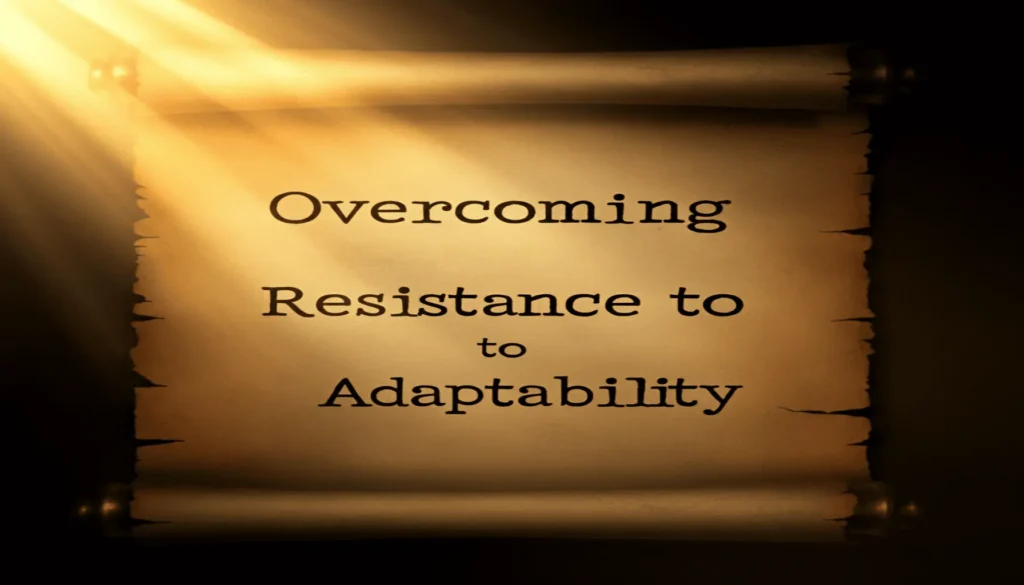
Even as adaptability becomes increasingly crucial in the workplace, many individuals and organizations struggle with resistance to change. Understanding and addressing this resistance is key to fostering a more adaptable work environment. Let’s explore how to identify sources of resistance and implement effective strategies to overcome them.
Identifying Sources of Resistance
Resistance to adaptability can stem from various sources, both at the individual and organizational levels. Recognizing these sources is the first step in addressing them:
- Fear of the Unknown
- Uncertainty about new processes or technologies
- Concern about job security in changing environments
- Comfort with the Status Quo
- Familiarity with existing routines and procedures
- Perceived loss of expertise or status
- Lack of Trust in Leadership
- Skepticism about the motives behind changes
- Poor communication of the need for adaptability
- Past Negative Experiences
- Previous failed change initiatives
- Personal setbacks from past attempts to adapt
- Organizational Culture
- Rigid hierarchies that discourage flexibility
- Reward systems that don’t incentivize adaptability
- Limited Resources or Skills
- Insufficient training or support for new skills
- Lack of time or resources to implement changes
To visualize how these sources of resistance interact, consider this diagram:

Strategies for Managing Change Effectively
Overcoming resistance to adaptability requires a multi-faceted approach. Here are key strategies to manage change effectively:
- Clear Communication
- Articulate the need for adaptability clearly and consistently
- Use multiple channels to reach all employees
- Provide regular updates on progress and successes
- Involve Employees in the Process
- Seek input and feedback from team members at all levels
- Create cross-functional teams to drive adaptability initiatives
- Empower employees to suggest and implement changes
- Provide Adequate Training and Support
- Offer comprehensive training programs for new skills
- Provide resources and tools to facilitate adaptation
- Ensure ongoing support throughout the change process
- Lead by Example
- Leaders should demonstrate adaptability in their own work
- Share personal stories of adapting to change successfully
- Recognize and reward adaptable behaviors
- Start Small and Build Momentum
- Begin with pilot projects or small-scale changes
- Celebrate early wins to build confidence
- Gradually scale up adaptability initiatives
- Address Concerns Proactively
- Anticipate potential objections and prepare responses
- Create safe spaces for employees to voice concerns
- Offer individualized support for those struggling with change
Let’s look at how these strategies can be applied in different scenarios:
| Scenario | Strategy | Example |
| Implementing new technology | Clear Communication & Training | Host town halls to explain benefits, offer hands-on workshops |
| Restructuring departments | Involve Employees & Address Concerns | Form employee advisory groups, provide career counseling |
| Shifting to agile methodologies | Start Small & Lead by Example | Begin with one team, have leaders participate in sprints |
| Adapting to remote work | Provide Support & Build Momentum | Offer home office stipends, share success stories regularly |
Building Support Systems for Adaptability Initiatives
Creating a supportive environment is crucial for sustaining adaptability efforts. Here’s how to build effective support systems:
- Establish Change Champions
- Identify influential employees who embrace adaptability
- Train them to support and guide others through changes
- Create a network of champions across departments
- Develop Mentorship Programs
- Pair adaptable employees with those who are struggling
- Encourage knowledge sharing and peer support
- Recognize mentors for their contributions to adaptability
- Create Feedback Loops
- Implement regular check-ins to gauge progress and challenges
- Use surveys and focus groups to gather insights
- Adjust strategies based on ongoing feedback
- Leverage Technology
- Implement collaboration tools to facilitate adaptability
- Use learning management systems for continuous skill development
- Employ analytics to track adaptability metrics and progress
- Foster a Learning Culture
- Encourage experimentation and view failures as learning opportunities
- Allocate time for learning and skill development
- Celebrate instances of successful adaptation
- Align Rewards and Recognition
- Update performance metrics to include adaptability
- Recognize and reward employees who demonstrate adaptability
- Share success stories to inspire others
To illustrate how these support systems work together, consider this diagram:

By implementing these strategies and building robust support systems, organizations can effectively overcome resistance to adaptability. Remember, fostering adaptability is an ongoing process that requires patience, persistence, and a commitment to continuous improvement.
For more insights on managing organizational change, check out Kotter’s 8-Step Change Model, a widely recognized framework for implementing change effectively.
As you work to overcome resistance to adaptability in your workplace, keep in mind that every individual and organization is unique. Be prepared to adapt your approach as you learn what works best in your specific context. With consistent effort and the right strategies, you can create a more adaptable, resilient, and successful work environment.
Real-World Examples of Adaptability in the Workplace

In this section, we’ll explore compelling case studies of successful adaptability across various industries. These real-world examples demonstrate how organizations and individuals have navigated challenges, seized opportunities, and thrived in dynamic environments. We’ll also distill key lessons from these success stories to help you cultivate adaptability in your own career or organization.
Case Studies of Successful Adaptability in Various Industries
Technology: Microsoft’s Cloud Transformation
Challenge: Declining PC market and increasing competition in the software industry.
Adaptive Response: Under CEO Satya Nadella’s leadership, Microsoft pivoted from a Windows-first strategy to a cloud-first, mobile-first approach.
Results:
- Azure cloud platform became a major revenue driver
- Market capitalization surpassed $1 trillion in 2019
- Rejuvenated company culture fostering innovation and collaboration
Retail: Target’s Digital Transformation
Challenge: Intense competition from e-commerce giants like Amazon.
Adaptive Response: Target invested heavily in its digital capabilities and same-day delivery services.
Results:
- Digital sales grew by 195% in 2020
- Successfully blended online and in-store experiences
- Remained competitive in the challenging retail landscape
Automotive: Tesla’s Manufacturing Innovation
Challenge: Scaling up production to meet demand for electric vehicles.
Adaptive Response: Tesla adopted an agile manufacturing approach, continuously iterating on its production processes.
Results:
- Achieved production targets for Model 3
- Pioneered new manufacturing techniques in the automotive industry
- Became the most valuable car company globally
Entertainment: Disney’s Streaming Pivot
Challenge: Declining cable TV viewership and competition from streaming services.
Adaptive Response: Disney launched Disney+ and restructured its media business to focus on direct-to-consumer offerings.
Results:
- Gained over 100 million subscribers within 16 months of launch
- Successfully competed with established streaming giants
- Offset losses from theme parks and theatrical releases during the pandemic
Hospitality: Airbnb’s Pandemic Pivot
Challenge: Global travel restrictions due to COVID-19 pandemic.
Adaptive Response: Airbnb quickly shifted focus to local and long-term stays, and introduced virtual experiences.
Results:
- Recovered from initial pandemic shock
- Successful IPO in December 2020
- Emerged stronger with a more diverse business model
To visualize the impact of adaptability across these industries, consider this comparative chart:

Lessons Learned from Adaptability Success Stories
From these case studies, we can extract valuable lessons on fostering adaptability:
- Embrace Digital Transformation
- Invest in technology that enhances flexibility and efficiency
- Develop digital competencies across the organization
- Foster a Culture of Innovation
- Encourage experimentation and calculated risk-taking
- Create safe spaces for employees to propose and test new ideas
- Prioritize Customer-Centric Approaches
- Continuously assess and respond to changing customer needs
- Use data analytics to anticipate market trends
- Develop Agile Leadership
- Train leaders to make quick, informed decisions in uncertain environments
- Promote cross-functional collaboration and knowledge sharing
- Invest in Continuous Learning
- Provide ongoing training and development opportunities for employees
- Cultivate a growth mindset across the organization
- Maintain Financial Flexibility
- Keep a robust cash reserve for unexpected challenges or opportunities
- Diversify revenue streams to mitigate risks
- Build Resilient Supply Chains
- Develop contingency plans for supply chain disruptions
- Foster strong relationships with multiple suppliers
To put these lessons into perspective, let’s look at a comparison of adaptive vs. non-adaptive approaches:
| Aspect | Adaptive Approach | Non-Adaptive Approach |
| Strategy | Flexible, regularly reviewed | Rigid, rarely updated |
| Innovation | Encouraged, resources allocated | Discouraged, seen as risky |
| Customer Focus | Proactive, data-driven | Reactive, assumption-based |
| Leadership | Agile, empowering | Hierarchical, controlling |
| Learning | Continuous, organization-wide | Limited, job-specific |
| Finances | Diversified, with reserves | Focused on short-term gains |
| Supply Chain | Resilient, multi-sourced | Efficient but vulnerable |
By studying these real-world examples and applying the lessons learned, organizations and individuals can develop their adaptive capabilities and thrive in an ever-changing business landscape. Remember, adaptability is not just about surviving disruption—it’s about leveraging change to create new opportunities and drive success.
Resources for Developing Adaptability
In our rapidly evolving world, the journey to becoming more adaptable is ongoing. Fortunately, there’s a wealth of resources available to help you cultivate and enhance your adaptability skills. Whether you prefer learning through books, online courses, or professional organizations, we’ve got you covered. Let’s explore some top-notch resources to boost your adaptability in the workplace.
Books on Workplace Adaptability
Dive into these insightful reads to deepen your understanding of adaptability:
- “Adaptability: The Art of Winning in an Age of Uncertainty” by Max McKeown
- A practical guide to thriving in unpredictable environments.
- “Mindset: The New Psychology of Success” by Carol S. Dweck
- Explores the power of our mindset in achieving success and adapting to challenges.
- “Who Moved My Cheese?” by Spencer Johnson
- A classic parable about adapting to change in your work and life.
- “Pivot: The Art and Science of Reinventing Your Career and Life” by Adam Markel
- Offers strategies for navigating career transitions and adapting to new professional landscapes.
Online Courses and Workshops
Enhance your adaptability skills with these interactive learning experiences:
- Adaptive Leadership (edX)
- Learn how to lead and adapt in complex, uncertain environments.
- Adaptability and Resilience (Coursera)
- Develop strategies to become more adaptable and resilient in your personal and professional life.
- Developing Adaptable Teams (LinkedIn Learning)
- Learn how to foster adaptability within your team or organization.
- Agile Fundamentals (Udacity)
- While focused on software development, this course teaches principles of agility applicable to many fields.
- Design Thinking and Innovation (Harvard Business School Online)
- Learn a problem-solving approach that enhances adaptability and innovation.
To help you choose the right learning path, consider this comparison table:
| Resource Type | Time Commitment | Interaction Level | Certification |
| Books | Flexible, self-paced | Low | No |
| Online Courses | 4-8 weeks typically | Medium to High | Often Yes |
| Workshops | 1-3 days typically | High | Sometimes |
Professional Organizations Focusing on Adaptability Skills
Engage with these organizations to network, learn, and stay updated on adaptability best practices:
- Association for Talent Development (ATD)
- Offers resources, conferences, and certifications related to talent development, including adaptability skills.
- Society for Human Resource Management (SHRM)
- Provides research, training, and events on various workplace skills, including adaptability.
- International Coach Federation (ICF)
- While focused on coaching, ICF offers resources on developing adaptability and resilience.
- Project Management Institute (PMI)
- Emphasizes adaptability in project management through its Agile certifications and resources.
- American Management Association (AMA)
- Offers seminars, articles, and webinars on various management topics, including adaptability.
Remember, developing adaptability is an ongoing process. Mix and match these resources to create a learning path that suits your needs and learning style. Whether you’re looking to adapt to a new role, navigate organizational change, or simply future-proof your career, these resources will equip you with the tools and knowledge you need to thrive in an ever-changing workplace.
Don’t hesitate to explore these resources and start your journey towards becoming more adaptable today. The future of work belongs to those who can adapt and evolve!
Conclusion: Embracing Adaptability in the Ever-Evolving Workplace
As we wrap up our deep dive into adaptability in the workplace, let’s take a moment to reflect on the key insights we’ve explored and consider how they can shape our professional futures.
Recap of Key Points on Adaptability in the Workplace
Throughout this article, we’ve uncovered the multifaceted nature of workplace adaptability:
- Definition and Importance:
- Adaptability is more than just flexibility; it’s a proactive approach to change.
- It’s crucial for both individual career success and organizational growth.
- Core Components:
- Growth mindset
- Emotional intelligence
- Problem-solving skills
- Strong communication and collaboration abilities
- Benefits:
- For individuals: Enhanced job security, career growth, and problem-solving skills
- For organizations: Increased innovation, competitive advantage, and resilience
- Strategies for Development:
- Continuous learning and skill enhancement
- Embracing challenges and diverse perspectives
- Practicing mindfulness and stress management
- Improving decision-making under pressure
- Adaptability Across Environments:
- Remote work
- Fast-paced industries
- Traditional vs. modern workplaces
- Industry-specific adaptations
- Leadership’s Role:
- Fostering a culture of adaptability
- Leading by example
- Supporting employee development
- Future Trends:
- AI and automation
- Hybrid work models
- Continuous upskilling and reskilling
The Ongoing Importance of Adaptability in Career Success
As we look to the future, it’s clear that adaptability will continue to be a critical factor in career success. Let’s visualize this with a forward-looking timeline:
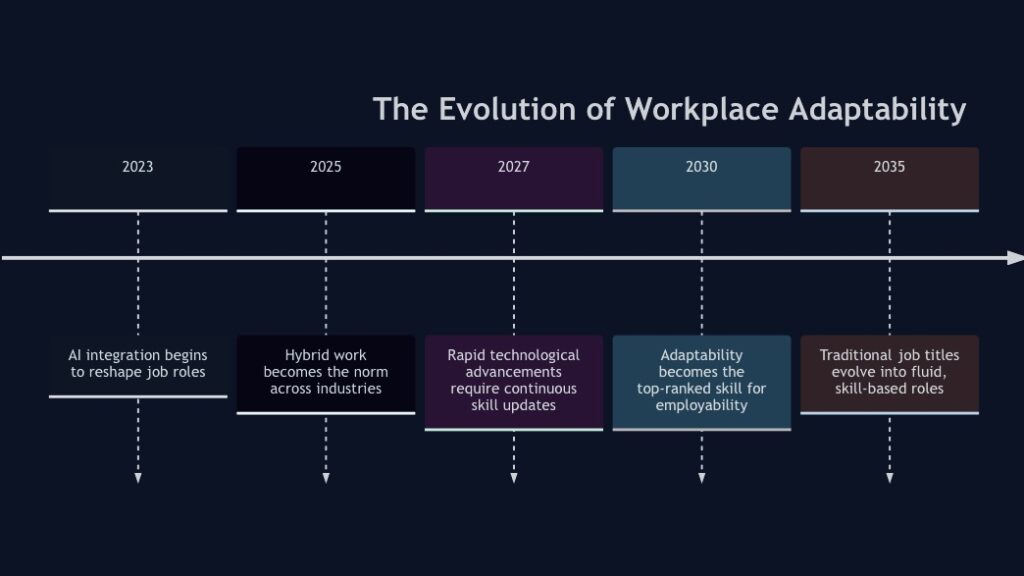
This timeline underscores the ongoing importance of adaptability. As the workplace continues to evolve at an unprecedented pace, those who can adapt will not just survive but thrive. Remember:
- Change is constant: The only certainty in the future of work is change itself.
- Adaptability is a competitive advantage: It sets you apart in a crowded job market.
- Career resilience: Adaptable professionals can navigate industry disruptions with confidence.
- Leadership potential: Adaptability is increasingly recognized as a key leadership trait.
- Personal growth: Embracing adaptability leads to continuous personal and professional development.
Now that we’ve explored the what, why, and how of adaptability in the workplace, it’s time to put these insights into action. Here’s a simple framework to get you started:
- Assess: Evaluate your current adaptability level using the tools and techniques discussed.
- Plan: Choose 2-3 strategies from this article that resonate with you.
- Act: Implement these strategies in your daily work life over the next 30 days.
- Reflect: After 30 days, assess your progress and adjust your approach as needed.
- Share: Discuss your experiences with colleagues or mentors to gain additional insights.
Remember, developing adaptability is a journey, not a destination. Every small step you take towards becoming more adaptable contributes to your long-term success.
We’d love to hear about your experiences with adaptability in the workplace. Have you successfully navigated a major change? Learned a new skill that transformed your career? Or perhaps you have questions about applying these strategies in your specific situation?
Share your thoughts, questions, and experiences in the comments below. Your insights could inspire and help others on their adaptability journey.
Let’s create a community of adaptable professionals who are ready to thrive in the dynamic workplace of today and tomorrow. Together, we can turn the challenges of change into opportunities for growth and success.
Your adaptability journey starts now. Are you ready to embrace the change?
Frequently Asked Questions: Adaptability in the Workplace
How do you demonstrate adaptability at work?
Demonstrating adaptability at work involves showing flexibility and a willingness to embrace change. Here are some practical ways to showcase your adaptability:
- Volunteer for new projects or roles outside your comfort zone
- Respond positively to unexpected changes or challenges
- Learn and implement new technologies or processes without hesitation
- Adjust your communication style to work effectively with diverse colleagues
- Offer creative solutions to problems, especially during times of change
What are the 5 ways of adaptability?
While adaptability can manifest in many ways, here are five key aspects:
- Cognitive Adaptability: The ability to adjust your thinking and problem-solving approaches
- Emotional Adaptability: Managing your emotions effectively in the face of change
- Social Adaptability: Adjusting your interpersonal style to work well with different people
- Physical Adaptability: Being flexible with your work environment or physical demands of your job
- Learning Adaptability: Continuously acquiring new skills and knowledge
What is an example of good adaptability?
A great example of adaptability is how many businesses pivoted during the COVID-19 pandemic. For instance, restaurants quickly adapted to offer takeout and delivery services, even if they hadn’t done so before. They adjusted their menus, implemented new safety protocols, and embraced digital ordering systems to survive and thrive in challenging circumstances.
What are the 6 keys to adaptability?
The six keys to adaptability are:
- Flexibility: Being open to different ways of doing things
- Resilience: Bouncing back from setbacks and challenges
- Continuous Learning: Constantly updating your skills and knowledge
- Emotional Intelligence: Understanding and managing your emotions and those of others
- Problem-Solving Skills: Finding creative solutions to new challenges
- Open-Mindedness: Being receptive to new ideas and perspectives
How can I show that I am adaptable?
To demonstrate your adaptability:
- Highlight specific examples in your resume and cover letter where you’ve successfully navigated change
- During interviews, share stories that showcase your flexibility and problem-solving skills
- Take on new responsibilities at work and document your successes
- Seek feedback from colleagues and supervisors on your ability to handle change
- Continuously update your skills and share your learning journey with your team
How to explain adaptability as a strength?
When explaining adaptability as a strength, focus on how it enables you to:
- Thrive in dynamic environments
- Learn quickly and apply new knowledge effectively
- Work well with diverse teams and in various situations
- Find innovative solutions to complex problems
- Remain calm and productive during periods of change or uncertainty
For example: “My adaptability allows me to quickly learn new technologies and apply them to improve our team’s workflow. During our recent system upgrade, I not only mastered the new software quickly but also helped train my colleagues, ensuring a smooth transition for the entire department.”
What are the 4 C’s of career adaptability?
The 4 C’s of career adaptability, as defined by career development researcher Mark Savickas, are:
- Concern: Being future-oriented and prepared for possible career tasks and challenges
- Control: Taking responsibility for one’s career development and decisions
- Curiosity: Exploring possible selves and future scenarios
- Confidence: Believing in one’s ability to achieve career goals and overcome obstacles
What is the best ability is adaptability?
The phrase “The best ability is adaptability” highlights that being able to adjust to new situations is often more valuable than any single skill. In a rapidly changing work environment, the capacity to learn, unlearn, and relearn is crucial for long-term success.
How do you list adaptability as a skill?
When listing adaptability as a skill on your resume or LinkedIn profile:
- Use specific examples: “Quickly mastered new CRM system, increasing team efficiency by 25%”
- Highlight related skills: “Flexible problem-solver adept at navigating ambiguity”
- Quantify your adaptability: “Successfully managed 5 major organizational changes in 2 years”
- Use relevant keywords: “Change management”, “Flexibility”, “Versatility”
What is a strong adaptability?
Strong adaptability is characterized by:
- Quick learning and application of new skills
- Comfort with ambiguity and uncertainty
- Resilience in the face of setbacks
- Proactive approach to change
- Ability to thrive in diverse and dynamic environments
How to be highly adaptable?
To become highly adaptable:
- Embrace a growth mindset
- Seek out new experiences and challenges
- Practice mindfulness to stay present and reduce stress
- Develop your emotional intelligence
- Cultivate curiosity and a love for learning
- Build a diverse network to expose yourself to different perspectives
- Reflect on past experiences of change and what you learned from them
What are some examples of adaptability?
Examples of adaptability in the workplace include:
- A marketing professional pivoting to digital strategies during a shift to online commerce
- An educator transitioning from in-person to virtual teaching during a pandemic
- A company retraining its workforce to use AI-enhanced tools rather than replacing employees
- An executive adjusting their leadership style to better motivate a multi-generational team
- A startup pivoting its product offering based on unexpected market feedback
What is the core value of adaptability?
The core value of adaptability is the recognition that change is constant and that success comes from embracing and navigating change rather than resisting it. It’s about maintaining effectiveness in the face of new challenges and opportunities.
What are smart goals for adaptability?
Here are some SMART (Specific, Measurable, Achievable, Relevant, Time-bound) goals for improving adaptability:
- Learn one new skill relevant to your industry each quarter
- Volunteer for a cross-functional project in the next 6 months
- Improve your emotional intelligence score by 20% in the next year through targeted training
- Successfully implement a major change initiative in your department within the next 12 months
- Increase your productivity by 15% when working in new or challenging situations over the next year
What is the first step to enabling adaptability?
The first step to enabling adaptability is developing self-awareness. This involves:
- Recognizing your current adaptability level
- Identifying your strengths and areas for improvement
- Understanding your reactions to change
- Assessing your learning style and preferences
Once you have this self-awareness, you can create a targeted plan to enhance your adaptability.
To visualize the process of developing adaptability, consider this diagram:
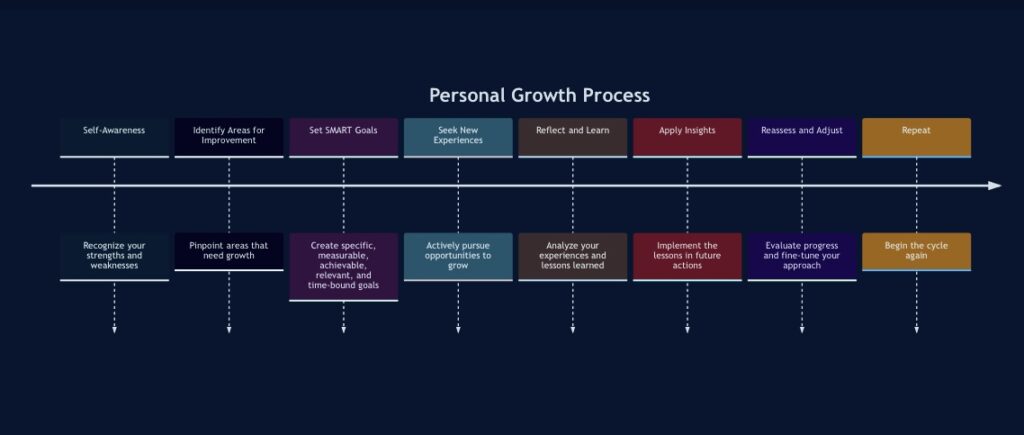
By continually cycling through this process, you can consistently improve your adaptability and thrive in an ever-changing workplace.

